9 vs 10.5 vs 12 Degree Driver Loft Chart & Guide

Most experienced golfers agree that driver loft is a very important factor in determining shot distance. A beginner of average golfer wants to know which loft is right for them.
There are three main types of driver lofts. In this guide, I’ll compare 9 vs 10.5 vs 12 degree lofts and tell you which one is right for you.
To determine which loft is best for you, you’ll need to consider several factors, such as:
- swing speed
- ball launch angle
- club head speed
Below, we’ll go into more detail about all of this. We’ll also teach you about some clubs with adjustable driver heads that can help you adjust your swing and get more distance:
- Cobra King Speeedzone
- TaylorMade Stealth Plus
- Tour Edge Exotics C721

What is Driver Loft?
9 degree loft, 10.5 degree loft, 12 degree loft, what is the best loft for a driver, why is loft important, driver loft chart, adjustable drivers: overview, best overall, best for experienced players, best for budget, swing and clubhead speed, angle of attack, age of club, frequently asked questions (faq).
Your loft determines how high your shot will go when the club strikes the ball at impact. There are also other factors to this such as your swing speed, angle of attack, and how high you are teeing the ball up.
But, in plain terms, the loft is the degree of angle formed from the ground and the club head when you set the clubsquarely on the ground.
In most case, the ideal driver loft depends on how fast your swing is. The faster the swing speed, the lower loft you will want in order to increase distance in your golf ball. The slower the swing speed, the higher lofted driver you will want as it will increase carry and roll.
One of the most important clubs in your golf bag is your driver. The reason it is important is because on most par 4s and 5s, this is what you are using off the tee in order to get yourself in a good position for your next shot towards the green.
It all comes down to personal preference but if you are wanting to take your golf game to the next level, you will need a solid driver to do so.
The 3 main options for loft are 9 degrees, 10.5 degrees and 12 degrees. I will go over these below. While you read, run the following video which goes over driver loft which is a great resource as well!
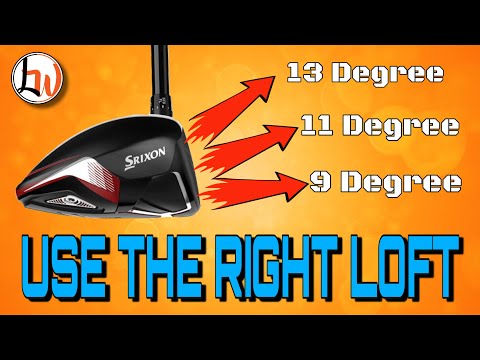
9 vs 10.5 vs 12 Degree Loft Comparison
When it comes to hitting a driver, there are a lot of variables to consider when choosing what loft is best for you. Things to consider are swing speed, launch angle as well as hitting up or down on the ball.
A 9 degree driver loft would be best for intermediate or advanced golfers who have a swing speed over 105 mph. This means that beginner golfers with slower swing speeds should not be considering a 9 degree golf club.
Players who are able to maintain a higher launch angle will benefit from using 9 degrees. The trajectory of the ball will be lower than at 10.5 degrees, so it will also benefit those who hit down on the ball.
Another reason amateur golfers should not have a 9 degree driver is that is diminishes the backspin of the ball and can create a lot of sidespin. Most average golfers already have a slice, which will be amplified if they were to use 9 degrees.
Mid to low handicap players that can maintain a straight shot will benefit from the added distance a 9 degree loft drivercan bring. The 9 degree driver will produce less backspin at impact as it moves at a lower angle of attack, which will allow the ball to carry a longer distance.
Most PGA professionals with a very fast swing speed, like Bryson DeChambeau , use a 9 degree loft (or even lower)!
Related: Check out the best golf drivers you can buy today.
A 10.5 degree driver loft is suited to the recreational golfer who has a slower swing speed or doesn’t hit the ball on an upward launch angle. Most golfers tend to hit downwards on the ball and a 10.5 degree driver will help you get the ball into the air even without the fastest of swings.
If you were to look at most stock drivers in a golf retail store, the majority of them would be 10.5 degrees. The reason for this is that recreational and higher handicap golfers make up a majority of the sport.
A 10.5 degree driver has a more positive attack angle than 9 degrees, which will give you a more optimal launch and less spin if your swing speed is lower.
If you are an average weekend player with a medium swing speed, I would definitely recommend going with a 10.5 degree driver. With the added loft, it will help you get the ball into the air and give the majority of average golfers more distance off the tee.
Just as I went over for 10.5 degrees, 12 degrees is much the same. A 12 degree driver is more suited for beginner and higher handicap golfers as it gives you an even higher launch off the tee to add some more distance.
A 12 degree driver loft is suited for golfers who have swing speeds under 95 mph and are looking for a little added distance off the tee.
Another benefit to a 12 degree club is that it allows you to hit the ball straighter due to an even more positive attack angle. The reason for this is that the higher the ball goes due to the loft of the driver, the less likely it is to have sidespin on the ball. When sidespin happens, it causes the ball to slice off to the side and most likely end up off the fairway in the rough somewhere.
A launch monitor sometimes calls this “smash factor”, which decreases with a higher driver loft angle.
If you were to use a 12 degree driver with a high swing speed, the higher loft of the driver will create more spin on the ball, which is a drawback. This will cause the ball to fly too high in the air and not as far distance.
That is why it really depends on what your swing speed is when deciding the correct loft.
This question is quite tough to answer because it is very subjective and ultimately comes down to personal preference for each player. The best way to determine which driver loft is best for you is to head into any golf retail shop and hit a few variations into the screen. The launch monitor there will tell you what kind of club head speed, ball speed, spin loft and launch angle you are working with. This will then give you the best idea on what degree will work best for your swing.
Once you have that information, you can hit a few different brands with different lofts to see what works best with your swing. Golf is a game of feel, so whatever feels best will work the best.
In our opinion, the best and most common loft is 10.5. It seems to be the sweet middle of not too much loft, but enough to get the ball into the air while maximizing the most distance.
Driver loft is important because having a club that you are comfortable hitting off the tee is important to succeed. Loft is also important because it dictates how high your ball fly’s into the air off the face of the club.
If you can consistently hit straight off the tee, you will give yourself easier shots after that to get a nice score and have a good day on the golf course.

A great way to see what degree loft is best for you is to look at the above chart. This chart does a great job showing optimal distance off the tee with different lofts, depending on what your swing speed is.
You can see that the slower swing speeds near the bottom of the chart trend upwards in distance the higher lofted they go. The high swing speeds at the top of the chart actually start to lose distance the more lofted they go because spin rate in the air actually causes a decrease in average driver distance.
One other great thing that ties into loft is the fact that some clubs come adjustable instead of having a static loft. What this means is that there is a screw on the head of the driver that you can unscrew and adjust the loft, lie and center of gravity on the fly.
Having a dynamic loft is a big perk for new golfers who are just learning the game.
You can purchase a 10.5 degree driver, but then adjust the head to have it play as a 10, 9.5 or even 11.5 degrees. If you want to try something new or you have an increased swing speed after a few rounds of practice, this is a great option.
Next, we’ll show you you some clubs with dynamic loft that you can adjust the launch angle on.
Best Adjustable Golf Clubs
- Cobra King Speedzone
The Cobra King Speedzone comes with an adjustable hosel that will allow you to choose from seven different lofts apart on the club. You adjust this using the wrench that Cobra provides you. You use the wrench to unscrew the head from the hosel and then spin it to where you want to use. You can either increase or decrease the loft, depending on what you are looking for.
Another thing that you can adjust is a draw or fade bias setting. Doing this will turn the clubface slightly to produce a draw or fade, depending on what you choose. These features sound advanced for average golfers, but are quite useful as you find the right golf swing.
Overall, the Speedzone has a very forgiving driver design that is made for the average golfer.
The other great thing about the Cobra King Speedzone is you get access to the Cobra Connect app on your smartphone. The app then tracks all of your hits, so you can actually see and compare how you hit the ball with different lofts. This will help you decide on the optimal loft.

The Stealth Plus is the newest release from TaylorMade and it is taking the world by storm on tour. The all new carbon face on the club is completely different from normal titanium. It is 44% lighter than a titanium face and the carbon layer delivers incredible ball speeds for maximum distance.
The Stealth Plus also has an adjustable hosel much like the Cobra King Speedzone. You can unscrew the head using the included wrench and adjust the loft up or down depending on what you are looking for.
Another cool new feature of the Stealth Plus is the sliding weight track. As the carbon face of the driver is lighter than usual, TaylorMade takes that weight savings and puts it into the sliding weight track. This allows you to unscrew the weight track and shift weight around to create your desired ball flight, draw or fade. Once you have the weight where you want, you just screw it back into place and start hitting!
The Stealth Plus is made for more experienced golfers with a faster clubhead speed. If you want modern drivertechnology though, it is the top of the pyramid. It is the club used today by Dustin Johnson, Tiger Woods , Scottie Scheffler , and more.
Click here to read our full review on the TaylorMade Stealth driver.

The last adjustable driver I am going to go over quickly is the Tour Edge Exotics C721 . This is a budget club that is perfect for a beginner player who is new to the game. It isn’t as expensive as other premium clubs, but can provide you with the same specs and flexibility.
The Exotics C721 has an adjustable hosel that allows you to adjust the loft up to 2 degrees up or down and also change the lie angle through a range of 3 degrees. It works the same as the others where you unscrew the head, twist the hosel to whatever loft you are looking for, click it back in and screw back in.
This club also includes adjustable sole weights much like the TaylorMade Stealth Plus. It is a 10 gram adjustable back weight that you can position to adjust the center of gravity setting on the club. You can optimize your hits and MOI on the club.
I would definitely recommend checking this out if you don’t want to spend a lot of money, but are looking for adjustability.

What Factors Affect Driver Launch Angle and Distance?
The loft is only one factor for a player to consider when trying to get longer distance.
How fast you swing the club will affect your performance on the course. A faster club speed will introduce spin on your golf ball. This is why professional golfers with fast swing speeds want a lower driver loft.
An average loft of 10.5 degrees with be suitable for a wide range of golfers.
DID YOU KNOW: You should also match your golf ball to your swing speed too.
The actual angle you make contact with the golf ball at will effect ball flights greatly. Having a high loft means nothing if you are swinging down on the ball at a negative angle. This is why having a dynamic loft could be big – you can adjust your loft to match your swing style.
When you make solid and straight on contact with the golf ball, you also minimize your ball spin. This will allow your ball flight to make a consistent and straight ball flight. When you swing inside-out or outside-in and make indirect contact with the golf ball, you add spin to it.
Spin introduces a slice or a hook and takes away distance from you.
Advancements in driver technology have really comet a long way in recent years. Modern clubs have tungsten weighting which lower the sweet spot and reduce the change of a mishit. It has allowed even the slowest swingers and senior golfers to play 10.5 degrees and has pushed 12 degree clubs nearly out of the market.
If you are buying an old club second-hand, then you could consider a higher loft to help you out.
Hopefully this loft guide helps you pick the right club for your skill level. The majority of clubs you will see are 10.5 degrees and are best for every golfer.
If you aren’t sure what to pick, measuring your average club head speed with a launch monitor will help you pick the right driver for distance.
Remember that the club angle is only one factor to how well you will hit the ball. Your actual loft, created by the upward attack angle of your club against the ball, is another factor that will effect the driver launch angle. Different driver shaftscan also effect your swing path too.
An adjustable driver can help you match your hardware to your golf swing type. Our picks for the best adjustable driversare:
These clubs can help you adjust loft at impact on the golf ball and allow you to play around with higher or lower-lofted drivers.
What is the average driver loft?
The most common loft that you will see is a 10.5 degree driver. This is right in the middle of most lofts available and will be tailored to the most golfers.
What loft do PGA Tour Pros use?
If you were to do a survey, you would probably find that most PGA Tour Pros use a 9 degree driver. PGA Tour golfers have some of the fastest swing speeds on the planet and they want to hit the ball as far as they can. Professional golfers will use a 9 degree driver loft in order to decrease spin for their faster swing speed.
Who is a 9 degree loft best for?
A 9 degree driver is best for low to mid handicap golfers with swing speeds over 100 mph. They are also good for golfers who are able to hit down on the ball with a downward angle because the lower loft will add backspin and increase distance off the tee.
Who is a 10.5 degree loft best for?
A 10.5 degree driver is an effective loft for recreational golfers who have swing speeds lower than 100 mph. The higher lofted driver will provide you with increased launch off the tee, which will provide more distance.
Who is a 12 degree loft best for?
A 12 degree driver is best for very slow swing speed golfers. The high loft will allow them to get lift on the ball off the tee in order to provide more distance.
Ryan William
With over 25 years hands-on experience in the golfing world, Ryan is not just an avid golfer but a topical authority. His journey has had him delve deep into the nuances of the sport, from mastering the swing to understanding new golf technology. As an entrepreneur, Ryan is at the forefront of the latest golf trends, reviewing all new clubs, accessories, and training aids. His insights and expertise are backed by a prolific writing career, with over 1000 articles published across various platforms. Ryan's commitment is clear: to guide and inform the golf community with unparalleled knowledge and passion.
Last update on 2024-06-24 / Affiliate links / Images from Amazon Product Advertising API
Leave a Comment Cancel reply
Save my name, email, and website in this browser for the next time I comment.
Modern Golf Apparel

Save on TaylorMade, Callaway & more!

What Driver is Most Used On the PGA Tour? Top 100 Player Analysis (2023 update)
Written by Graeme Hay | Last Updated: 21/05/2024
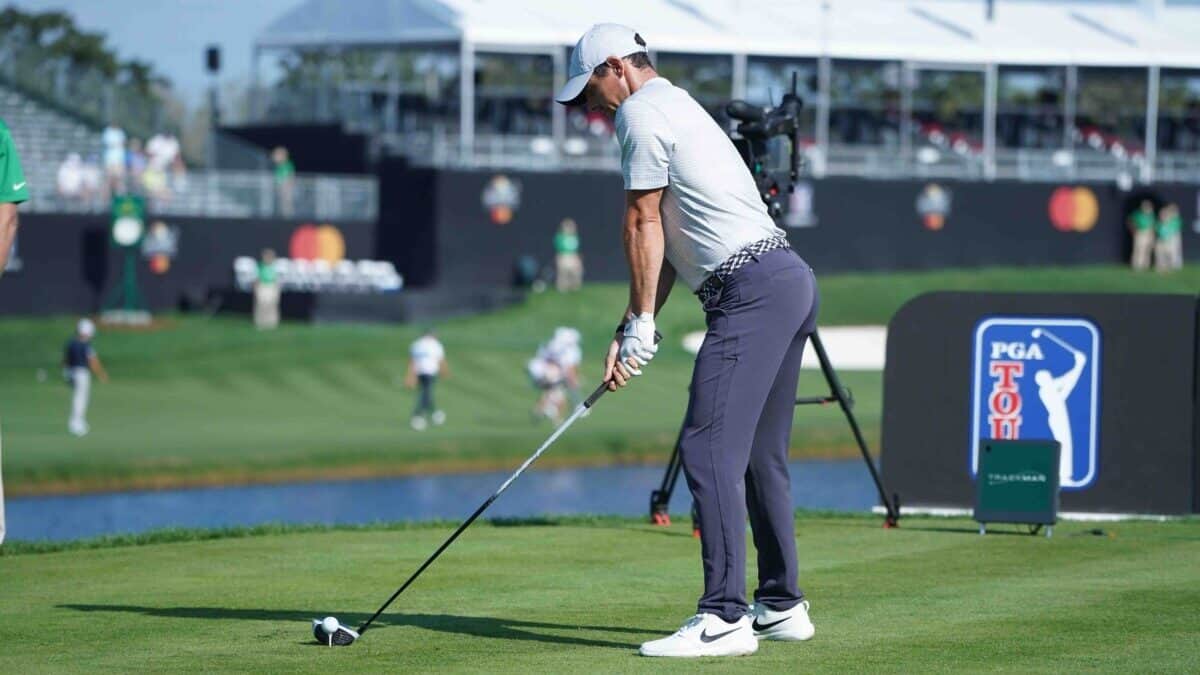
The driver is almost always the most talked about golf club in everyone’s bag.
And a good part of the reason for that is the average golfer often watches with wonder as the best players on the PGA Tour smash the ball seemingly endless distances down the middle of the fairway.
It seemed not that long ago that the 300 yard mark was the benchmark for the very long drivers on tour but now it appears you need to be hitting the ball 400 yards every now and then to be truly considered one of the game’s ‘big hitters’.
So what drivers are the pros using to achieve these huge distances?
We took a look at the top 100 players on the PGA Tour and analysed in detail the driver each of them carries to try and find what is the most common driver set up among the top pros.
Titleist’s TSR3 is the most used driver among the top 100 PGA Tour pros with 16 choosing it, including Justin Thomas and Max Homa. PING’s G430 LST is the next most popular model with 13 playing it while TaylorMade’s Stealth Plus and Callaway’s Paradym Triple Diamond drivers rank equal 3rd with 9 pros each using them.
The make and model of any driver only tells us so much though and when we looked at the drivers being used by this elite group it was fascinating to see the variance in lofts and also the multitude of different shafts being used.
It was also very interesting to note what has changed since we last carried out this detailed analysis two years ago!
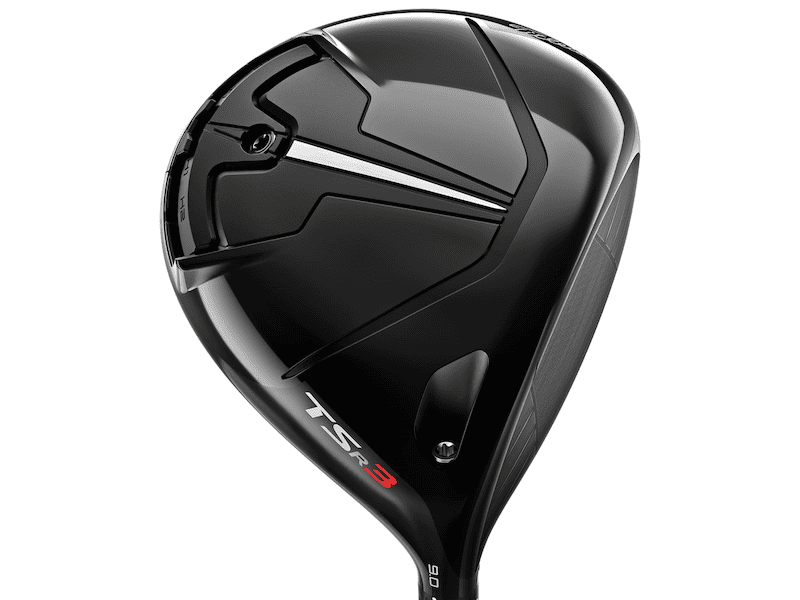
Most Played Driver on PGA Tour? Titleist Are Getting More Popular!
The amount of equipment available to PGA tour players is clearly on a different scale to anything that mere mortal amateurs can aspire to.
If a Tour pro wants to test out a new driver, shaft or set up it’s immediately made available to them and they are able to swap out drivers as often as they want from tournament to tournament or even practice session to practice session.
It’s no surprise therefore that we discovered 24 different models of driver being used by the top 100 pros on the PGA Tour but the big brands of Titleist, PING, TaylorMade and Callaway very much dominate accounting for 90 out of the 100 drivers in play.
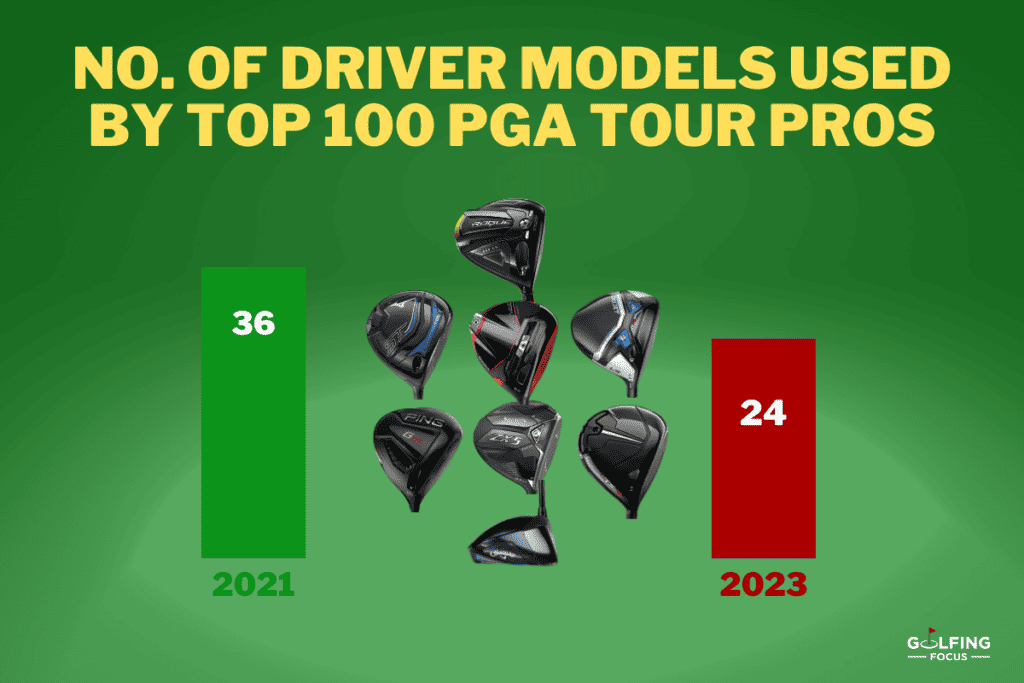
What was interesting to note though was that Titleist’s dominance among the big manufacturers has grown since the last time we did this in-depth study a couple of years ago.
Titleist drivers are the most played by the top 100 PGA Tour pros with 33 using them. PING models are the next most popular with 22 picking them. Rory McIlroy and Tiger Woods’ driver brand of choice, TaylorMade is used by 19 pros. Callaway drivers are chosen by 16 of this group with Srixon drivers being used by 6 of them.
Compared to two years ago this means an extra 6 out of the top 100 PGA Tour pros (33 in 2023 vs. 27 in 2021) now consider Titleist to be the best drivers for them therefore further reducing the market share of the other big brands among this elite group.
What also becomes very apparent once again when you look in detail at the drivers used by the PGA Tour pros however is the huge number of different set ups and each driver is clearly custom fitted to a very exact extent for each player.
For example even though 13 out of the top 100 use a PING G430 LST driver you can bet your last dollar when you look closely that there will be a unique set up for each player whether that be achieved through an adjustment to the loft, set up or shaft.
It is noticeable also that not all the players are in a rush to move immediately to the latest model of their preferred brand of driver and do continue to play with older drivers.
So to give the full picture of how many and which pros are using which brand and model of driver here is the complete breakdown of the drivers used by the top 100 players on the PGA Tour in order of popularity.
What Degree of Driver Do the Pros Use? It Starts With a 9 Most of the Time
Once upon a time a driver used to come with one loft option and players were stuck with it.
Modern golf technology has obviously moved on hugely since then and the loft options available to golfers now, and especially at the elite PGA Tour level, are incredible.
The Titleist SureFit Hosel system for example features a sleeve and ring set up each with 4 settings and as a result enables 16 unique loft and lie angle combinations with a precision of up to 0.75 degrees between different options.
The players on the PGA Tour are the best in the business and when it comes to the degree of driver they use it seems clear that the exactness with which they approach it and their overall driver set up is part of the reason they are so successful.
9 degrees is the most used driver loft among the top 100 PGA Tour pros with 32 setting up with it, including Rory McIlroy. 14 of this group play a 9.5º loft. The next most played degree of driver is 10.5º chosen by 8 pros with 8º and 10º used by 7 each. 6.5º is the lowest driver loft in the top 100 and 12.1º is the highest.
It is common also for the top pros to change the loft of their driver occasionally depending on what the course they are playing demands but below is the current breakdown of driver lofts played by the top 100 PGA Tour players.

What Driver Shaft is Most Used on the PGA Tour? There’s Weight Too!
PGA Tour pros are incredibly precise when it comes to the setup of their drivers and nowhere is that more evident than when it comes to the shafts that they choose to use with the biggest club in their bag.
When we carried out our analysis of the driver shafts being used by the top 100 players on the PGA Tour two years ago we found 70 different models being used and that number has now increased to 73 in 2023.
Fujikura’s Ventus Black 6X is still the most used driver shaft among the top 100 PGA Tour pros with 7 choosing it. The Ventus TR Blue 6X is the next most popular chosen by 5 players. Graphite Design’s Tour AD DI 6X and Fujikura’s Ventus Black 7X shafts are the third most common with three pros each picking them.
That almost every one of the top 100 pros is using a shaft that is unique to them however shows how must care the best players in the world take when it comes to making their choice and that attention to detail is again clearly evident when it comes to the driver shaft weights they use.
The most popular driver shaft weight used by the top 100 PGA Tour pros is 65g with 14 players selecting it, including Jordan Speith. 10 each use heavier shafts of 68g or 76g with 69g shafts the next most common weight being used by 7 pros . 56g is the lightest driver shaft among the top 100 with 90g the heaviest.
Interestingly while our analysis of the shafts the best pros on Tour use across all their clubs (which you can see here ) shows that True Temper is the shaft choice amongst the irons used by the top 100 this is not the case with driver shafts.
Once again when it came to driver shafts we found Fujikura models are the most popular driver shaft brand increasing their share among the top 100 PGA Tour pros from 28 two years ago to 34 in 2023.
Mitsubishi driver shafts, including the Tensei and Diamana series, remain the second most used in this elite group with 25 golfers using them.
True Temper shafts meanwhile are only the 3rd most popular in the drivers of the top 100 PGA Tour pros with 15 choosing them and all opting for shafts within the Project X HZRDUS range
Graphite Design driver shafts by comparison are the choice of 13 of this group.

Before you go ….
Knowing what drivers the top pros are using to hit the ball as far as they do is one thing but how much does their equipment explain the huge distances they hit the ball both off the tee and with seemingly every club?
Read our next article to find out the key reasons why the pros hit the ball as far as they do, including how much of a role their clubs play, and how you can potentially add 20 to 30 yards to your own drives!
How Do Pros Hit the Ball So Far?
[Note – Just so you know, and we are upfront as an affiliate program participant, Golfing Focus, at no cost to you, earns from qualifying purchases made through links on this page.]
Other top posts related to this topic:
- What Clubs Do Pro Golfers Use? Top 100 PGA Tour Player Guide
- The Fairway Woods Used by the Top 100 PGA Tour Pros
- What Hybrid Golf Clubs Do the Top 100 PGA Tour Pros Use?
- What Driving Irons Do the Pros Use on the PGA Tour?
- What Irons Do the Pros Use? Top 100 PGA Tour Player Guide
- What Wedges Do the Pros Use? Top 100 PGA Tour Player Analysis
- What Putters Do the Pros Use? Top 100 PGA Tour Player Guide
- What Golf Balls Do the Pros Use? Top 100 PGA Tour Players Breakdown
- What Golf Grips Do the Pros Use? Top 100 PGA Tour Player Guide
- What Shafts Do Pros Use? Top 100 PGA Tour Player Breakdown
- Do Pros Use Regular or Stiff Shafts? They’re Stronger Than That!
- Do Pros Use Graphite or Steel Shafts? It Depends Which Club
- Do Golf Pros Wear Metal Spikes? But They are Banned!
- In The Bag: Unpacking The Clubs Champions Tour Players Use
- What Clubs do LPGA players use? Top 50 Player Breakdown
Leave a Reply Cancel reply
Your email address will not be published. Required fields are marked *
Save my name, email, and website in this browser for the next time I comment.
RECENT ARTICLES

What Golf Balls Do LPGA Players Use? They’re Not Very Lady Like! (2024 update)

Behind Every Stroke: The Most Popular Putter on Champions Tour (2024)

Champions Hybrid Heroes. Most Used Hybrids by Champions Tour Pros (2024)

The Go-To Fairway Woods of Senior Tour Champions (2024)

Flexible Friends: Uncovering the Shafts Champions Tour Players Use (2024)
LEGAL INFORMATION
This site is owned and operated by Golfing Focus Limited, a private limited company whose registered office is in London, UK. Golfing Focus Limited is a participant in the Amazon Services LLC Associates Program, an affiliate advertising program designed to provide a means for sites to earn advertising fees (at no cost to you) by linking to Amazon.com. Golfing Focus Limited also participates in other affiliate programs with the eBay Partner Network, FlexOffers, CJ.com, Svorn and other sites and is compensated for referring traffic and business to these companies (again at no cost to you).
Our Socials

Disclosure: When you purchase through links on our site, we may earn a commission. As an Amazon Associate I earn from qualifying purchases. Learn more>

Critical Decision: What Driver Loft Should You Use
Golf is a never ending quest to try and play your best. Whether that means changing your swing, buying new equipment, getting lessons, and everything in between.
One area that can have a big impact on your game is your driver. Some average golfers fear a driver and leave it in the bag for their more trusty 3-wood. While others love their driver and hit it as often as possible.
The better you can hit it off the tee, the easier it is to score well. While there are a lot of components to becoming a good driver of the golf ball , the loft on your driver is a big factor.
I’m sure you’ve asked yourself, “What loft should my driver be?”
As you’ll learn today, picking the right driver loft can be easy or slightly complex to try and get the most distance possible. But the last thing I want to do is overwhelm you with technical jargon that might not help you play better golf.
So, to help you find the perfect driver loft, I broke this into two parts; the beginner version (for everyday recreational golfers) and the advanced version (for those who are serious about reaching their golf potential).
Driver Loft Pt 1: Beginner
If you’re struggling to hit the ball consistently well off the tee, your loft might be to blame. While there are a lot of factors to consider including the driver head, shaft weight, shaft flex, and more, loft should be a top priority.
Too many golfers try to hit a lower lofted driver to get more distance. This is because most people think about loft and assume, “Higher loft means the ball won’t go as far.”
While it makes sense in theory as your 6-iron has much less loft than your pitching wedge and thus, goes much farther. But you also need to consider shaft length and club speed too.
When it comes to driver ball flight, it’s an entirely different story. Playing an 8-degree driver vs. a 10-degree driver doesn’t guarantee that you’ll hit it longer. For some golfers this might be the case but everyone has to experiment to find the optimal loft.
Let’s dive into why that’s the case…
Most Golfers Need More Driver Loft
If you’re an everyday golfer, remember these two statements:
- Driver loft can help you hit if further
- More bounce can help you get out of the bunkers
While I won’t go into why bounce is your friend in the bunkers (read more about that here ), driver loft is also an ally for most players. The first reason why more loft is a good idea for the everyday golfer is that it will help you hit it longer (with both carry distance and maximum distance).
So, how does more loft help you hit it further?
Loft can help golf balls stay in the air longer and thus, have more carry and roll for longer total distance. This is especially good for those with a slower swing speed or don’t have an upward attack angle. There is a reason beginner drivers all have higher lofts.
Another reason why most players can benefit as much loft is accuracy off the tee. Because who doesn’t want to hit more fairways ? For most golfers, a slice is all too common and a lower lofted driver can actually make it even worse.
The lower the loft on your big stick, the easier it is to have a more severe slice. If you’re slicing the golf ball more than you care to admit, you would benefit from a 10.5 degree or maybe even 11+ degree driver. This will help straighten out your ball flight and likely increase total distance too.
Standard Driver Lofts
So, what is the best driver loft without getting into all the details the average golfer doesn’t need?
Driver lofts for most golf clubs range from roughly 8-11 degrees. For example, the popular Callaway Rogue ST Max driver has three options; 9, 10.5 degree, and 12 degree actual loft. While the TaylorMade Stealth is available in the same three options.
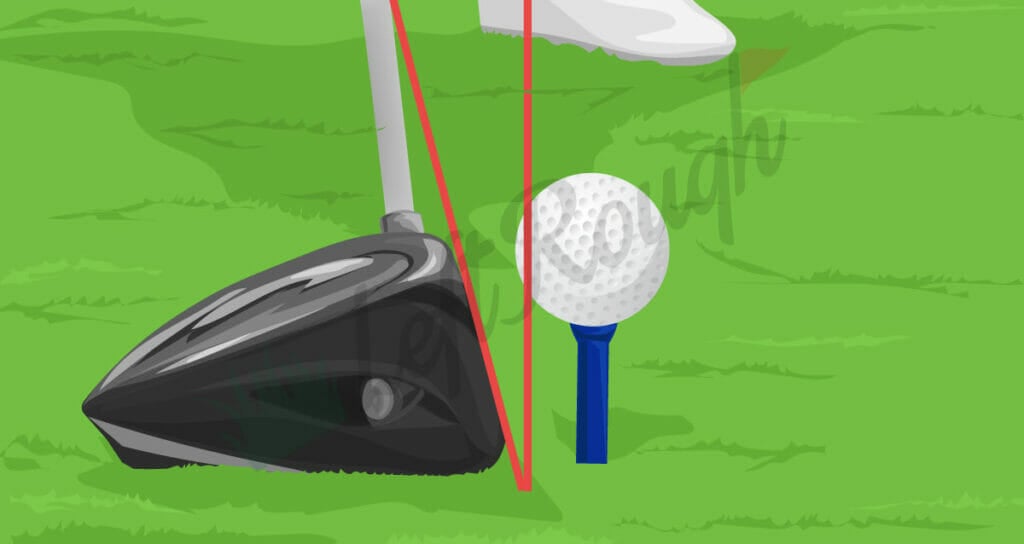
Like other golf equipment, these are adjustable drivers on the market . Which means you can hit the ball higher and have a higher launch angle by adjusting a new driver .
Overall, the best loft is a higher lofted driver that will benefit the majority of players. 9.5-10.5 degrees of loft. Paired with the right ball position , a shaft that helps get the proper spin rate , and proper driver attack angle will lead to more consistent drives.
Faster swing speeds or those who have downward attack angle might benefit from less loft (more on that in the next section).
Driver Loft Pt 2: Advanced
The first section is a good starting point but there’s a lot more we can get into when it comes to finding the correct loft on your new driver. If you’re reading this section, chances are you’re ready to geek out some golf knowledge to play your best.
Getting the right golf clubs, including driver loft, can help your ball flight, consistency, and confidence. Here are some other factors to consider when it comes to picking the right loft for your driver.
Swing Speed
The first thing you need to figure out before deciding on a loft is your swing speed.
So, why is swing speed so important?
Swing speed is the speed of the club that is traveling right before impact (also known as club head speed ). The faster the speed, the more distance.
The highest recorded speed ever was 156 mph by Connor Powers during the 2014 World Long Drive Championship. Obviously, 99.99% of us aren’t long drive champions and thus, need a different loft to match a lower swing speed.
So, what’s the average speed for a male golfer?
According to a study from Trackman , who collected data from more than 10,000 golfers, the average male amateur has a 93.4 mph club speed for a total distance of 214 yards .
The study also found that only 7% of players swing over 110mph (the PGA Tour Average is 113mph and LPGA is 94mph) and 45% of players were between 91-100mph.
This is the most common swing speed for the everyday golfer. Take a look at the graph below to see more average swing speed numbers. ( Make sure to read the full article on average distances for golfers . )

So, why does all this matter when it comes to picking the right loft for your driver?
Because the more speed you create in your swing, the less loft you likely need with a driver.
One of the more general rules in Golf Digest, Golf Magazine, and other publications is that higher handicap players need more loft. This is a general rule but as you’ll learn below, there are other factors too. This is because slower swing speeds don’t have as much speed and those players can’t get the ball high enough to max out distance.
A lot of times golfers would buy a club that didn’t have enough loft and their drives would suffer as a result.
How to Measure Swing Speed
Step one is measuring your swing speed which is pretty easy thanks to personal launch monitors . If you’ve already bought your own launch monitor for a golf simulator setup or to make practice more efficient, use it to measure your driver swing speed.
After warming up for 20-30 balls, work your way up to hitting the driver. Then, hit 10 shots and notate the average swing speed (not to be confused with ball speed ) of the driver. Take the average of the 10 balls and you will have a baseline to work with.
If you haven’t invested in a personal launch monitor yet, you can also get this measurement at your local golf store. You don’t need to do a personal club fitting either and they should help you 100% free.
Go here to read our full article on how to measure your swing speed.
Attack Angle
The second metric to figure out before picking loft is your attack angle.
This Golf Digest article provided some extra insight about the importance of attack angle. Specifically, how players now have a positive attack angle, which wasn’t always the case in the past.
“With an upward angle of attack, a player creates a more dynamic loft at impact, or the way the loft measures at impact compared to its static measurement. With less measured loft, an upward angle of attack and more dynamic loft, you’re creating the opportunity for high launch and less spin, a key metric for longer drives that hit the ground on a flatter angle, leading to more rollout.”
The same article went on to discuss how attack angle is changing. The PGA Tour average actually has a negative attack angle vs. the LPGA Tour where players have a positive attack angle. The upward angle compared to a downward angle is quite different and why each type of player needs the right loft for their golf swing.
Launch Angle
The third thing to think about is launch angle which is different from attack angle. Launch angle is referred to as the angle the ball takes off relative to the horizon. This number is closely related to dynamic loft which we’ll cover in the next section.
According to certified fitter Jamie McConnell, “Having the correct launch angle and combining it with the correct spin rate is really important in order to get the most out of a golfer’s clubs during a fitting. Too high or too low a launch angle and the golfer will lose distance.”
The average launch angle on the PGA Tour is just shy of 11 degrees while the LPGA average is about 13 degrees. What about amateure golfers?
Trackman found this data for male amateurs launch angles:
- Scratch or better = 11.2 degrees
- 5 handicap = 11.2 degrees
- 10 handicap = 11.9 degrees
- “Average handicap golfer” (14.5) = 12.6 degrees
- 18 handicap = 12.1 degrees
Dynamic Loft
In the past, it was easier for players to learn which loft they needed based on clubhead speed and skill level. But something called dynamic loft is making it a little more complex when it comes to picking the right driver loft.
Trackman Golf describes dynamic loft as, “The vertical angle of the club face at the center-point of contact between the club and ball at the time of maximum compression. Dynamic Loft is the amount of loft on the clubface at impact and is measured relative to the horizon.”
So, what affects dynamic loft?
A lot of factors including:
- How the shaft bends at impact
- How the golfer releases the club
- Attack angle (as previously mentioned)
- The club face (open or closed to the path)
- Where the club makes contact with the ball
This is why it’s not as simple as saying slower swing speeds need more loft. Does that rule hold true for the most part? Yes, but it’s not quite as cut and dry as it was in the past now that we can measure dynamic loft.
But as Trackman discussed in the same article, dynamic loft is wildly important. Here’s why…
“Creating the proper dynamic loft is important to creating the optimal trajectory and maximizing carry. Too much dynamic loft can send the ball too high into the air and reduce the golfer’s distance. Too little dynamic loft can send the ball too low making the ball roll out excessively causing it difficult to judge distance.”
Here are the Trackman averages of dynamic loft based on different type of handicaps:
- Scratch or better = 13 degrees
- 5 handicap = 13.2 degrees
- 10 handicap = 14.1 degrees
- “Average handicap golfer” (14.5) = 15.1 degrees
- 18 handicap = 14.3 degrees
Dynamic loft is an important factor in dialing in the right loft and why working with a club fitter might be the best solution.
Spin Rates
The final thing to consider with picking the right driver shaft and loft are the spin rates. This is where you might need to work with a fitter to try out different shafts. For solid ball strikers, playing the right shaft is arguably more important than loft or clubhead.
The wrong shaft can make golf a lot harder as your misses will be all over the golf course. But the right shaft can make the game a lot easier by creating consistent shots and a tighter shot dispersion .
According to Graff Golf, “When the average PGA Tour player hits a driver, their spin rate is typically in the area of 2,700 RPMs. For a player who is a scratch handicap, their average is right around 2,900 RPMs. If you are a 10-handicap, you are probably around 3,200 RPMs.”
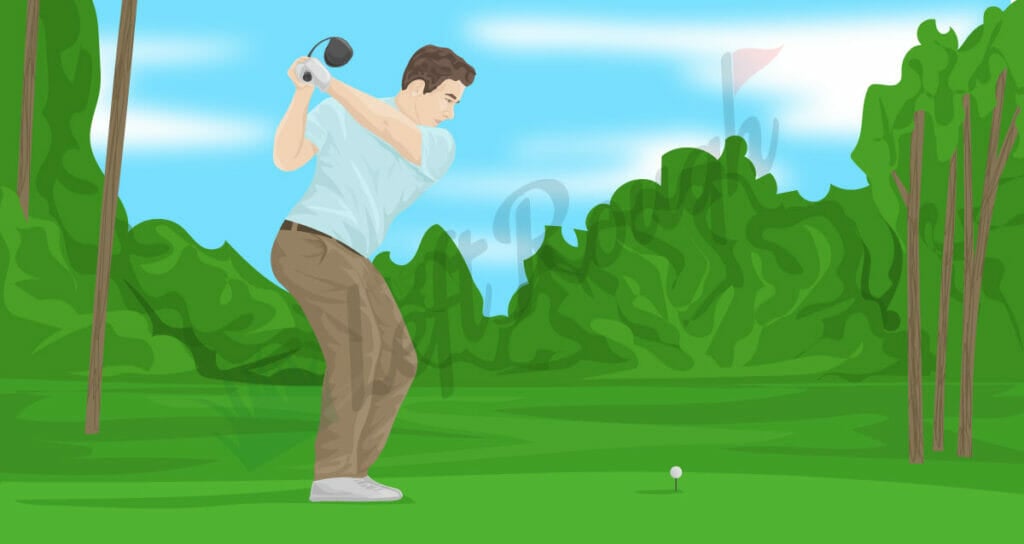
FAQs About Driver Loft
Do you still have questions about finding the right amount of loft for your driver? Check out our FAQs and answers below to find out more now.
What loft driver do pros use?
Professional golfers use all types of loft and are 100% dependent on their swing speed, attack angle, launch angle, and other factors. As mentioned above, one of the most important factors for elite golfers is dynamic loft.
Andrew Rice of Berkeley Hall Golf Club had this to say about dynamic loft. “Dynamic loft often will show me what a golfer is capable of, as better golfers seldom hit shots with too much dynamic loft. Learn to deloft the club face into impact and you are well on your way to being able to compress the golf ball.”
The best players in the world are used to delofting the club but swing speed, ball speed, and other factors come into play with driving off the tee. For example, Bryson DeChambeau uses a very little amount of loft.
As quoted in Golf Monthly , “Bryson was using a Cobra King Radspeed driver which had only 7.5 degrees of loft but in 2022 he has switched to a Cobra LTDx which only has five degrees of loft.”
Most golfers would get the ball more than 10 feet off the ground with that little loft. While other pros like Justin Thomas play a driver with 9.5 degrees of loft.
Needless to say, there’s a big gap between the lofts of professional golfers. Some might go as low as five like Bryson, while others play more conventional lofts.
Should I do a driver fitting?
If you’re a committed golfer and someone who takes your game seriously, I think a driver fitting is the best $100 (or so) you can spend. Think about it, the driver sets up your approach shots on nearly all par 4s and par 5s. The better you can hit your driver, the easier you’ll have it 14/18 holes during the round.
As you can tell from the advanced section above, there are a lot of components when it comes to getting the right loft. For solid golfers it’s not as simple as just playing a little more loft. There are so many factors to consider including shaft flex, shaft weight, overall club weight , driver head, driver loft, hosel settings, and more.
You want to have an enormous amount of confidence with your driver, which is why it’s such a good idea to get a custom club fitting . Plus, the fitter will usually give you some best practices on how to match your fairway wood and hybrids based on your driver settings.
What is spin loft?
Spin loft is another piece of data that can help you find the best loft for your driver.
According to Peter Field Golf , “Spin loft is approximately the angle between the dynamic loft and attack angle. Spin loft is actually the three-dimensional angle between the direction the club head is moving (both club path and attack angle) and the direction the club face is pointing (both face angle and dynamic loft).”
What is the difference between 9.5 and 10.5 degree driver?
The difference between the two lofts is only one degree. But depending on your golf swing, speed, and other factors, it can have a big impact. One degree more or less with your driver loft can change your total distance, accuracy, and ball flight.
Most adjustable drivers allow you to change the loft about two degrees with each club. Which is why it’s a good idea to test out different lofts on the range to see which performs best.
For most every day, mid to high-handicap golfers, 10.5 loft will help driving performance. Older golfers shopping for senior drivers should always consider a minimum of 10.5 degrees of loft and even experiment with a little more loft.
Will a lower loft driver go further?
Maybe, a lower loft driver will usually make the ball go further if the conditions are right. Lower loft means a lower trajectory, which if the conditions are firm or fast, will increase the total distance.
However, if the conditions are wet and cold, lower loft might actually hurt your distance.
Should you add loft to your swing?
Christop Bausek of Progress Golf said this on Trackman’s website about adding or taking away loft in the swing:
“Dynamic loft is a very good indicator of whether a golfer is adding too much loft or delofting the club too much. But be careful with drivers…hitting the ball high on the face will create a higher dynamic loft due to the roll of the club face.
Dynamic loft is the main factor for launching a ball into the air. There is a myth that “hitting down on the ball gets the ball up. Instead, pay attention to the dynamic loft if you want to get the ball up.”
Remember, a teeing up a driver and requires you to hit up on the ball. This is not the time to hit down on a golf shot. You want to tee the ball high and hit up on the ball.
Does a higher loft driver help my slice?
More loft can help reduce your driver slice but it’s not an instant cure. However, adding loft and adjusting your clubhead to a draw setting can make a big difference. They also make anti-slice drivers that have offset made to minimize the slice.
But don’t forget, this is a short-term solution. Fixing your slice means changing your grip , backswing, or something else in your swing. This usually takes some more extensive practice time to make the changes stick.
While you’re making swing changes, it’s always a good idea to optimize your driver settings to help you in the short term.
What degree driver does Tiger Woods use?
Throughout his illustrious career, Tiger has played all sorts of different equipment. Currently, according to the PGA Tour , Tiger is playing a 9-degree TaylorMade Stealth Plus driver. But he isn’t opposed to changing out shafts and club heads on a week-to-week basis.
It’s still hard to believe that in his dominance in the early 2000s this guy was playing a steel shafted driver! And absolutely lapping the field in terms of most distance.
Final Thoughts to Maximize Distance
Driver loft is an important part of your tee game and something you need to consider. As you can tell, you can make it easy or wildly complex but it depends on your skill levels.
For the majority of amateur golfers with a 14+ handicap, slightly more loft will help with distance and accuracy. But since most drivers are adjustable, it’s worth trying out on all settings to see how more/less loft impacts distance and trajectory.
For single digit handicap golfers and scratch golfers, driver loft is a component but not the end all be all number. You still need to consider dynamic loft, attack angle, launch angle, driver shaft, and more. It’s best to use a launch monitor and/or get a professional fitting to make sure the most important club in the bag is dialed in.
Regardless of skill level, don’t be afraid to experiment with different lofts, club heads, and driver shafts . The driver is one of the three most important clubs in the bag so make sure it’s optimized for your game.
What Driver Loft Should You Use? (Full Chart Based On Swing Speed)
Fact Checked By Ben Jenks
A 10.5° golf driver loft is ideal for beginners and most golfers. If you’re new to golf or have a slower swing speed, a driver with a higher loft will suit you better. A higher loft driver is more forgiving since getting an upward attack angle is easier.
Less loft allows you to gain more distance and less spin. Generally, the faster your swing speed, the less lofted driver you need.
I see many golfers play with the wrong driver loft, which hurts your drives. The lofts in drivers usually range from 8° to 14°.
To help you visualize, I’ve also made a driver loft chart. If you read this article carefully, you’ll understand which driver loft you’ll need as your game evolves.
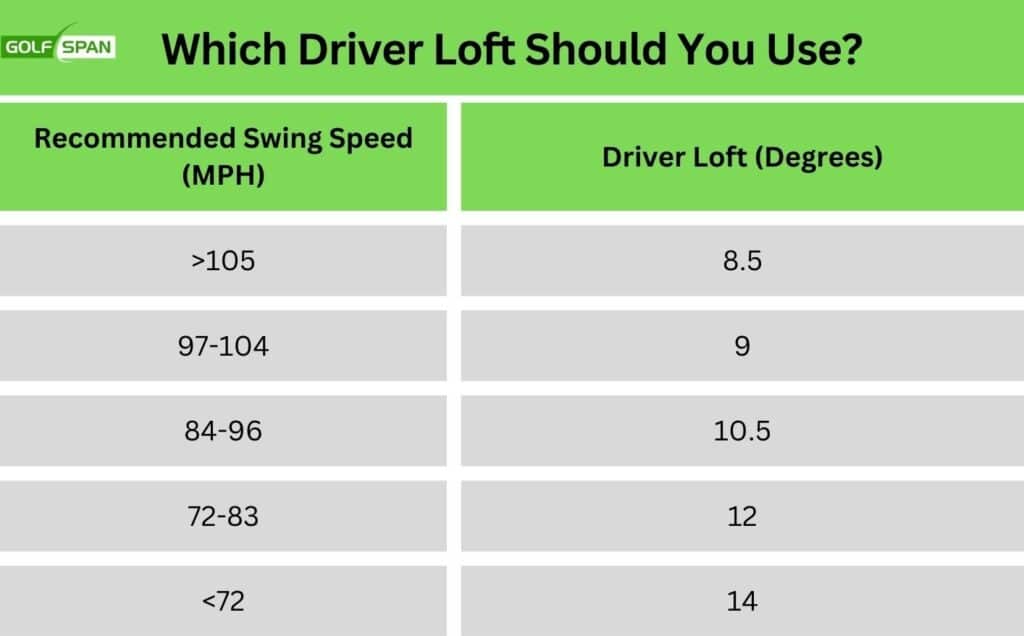
Note: You can estimate which driver loft will suit you and your swing speed, but finding the best one for every golfer will be different. That is why I always recommend getting your clubs fitted . Check out Brendon’s full club fitting experience at the PGA Tour Superstore .
What Driver Loft Should High Handicappers Use?
What driver loft should low handicappers use.
- Who Should Use a High Lofted Driver?
Who Should Use a Low Lofted Driver?
Is a higher loft driver better, what loft should i use for my driver, does lowering driver loft open the face.
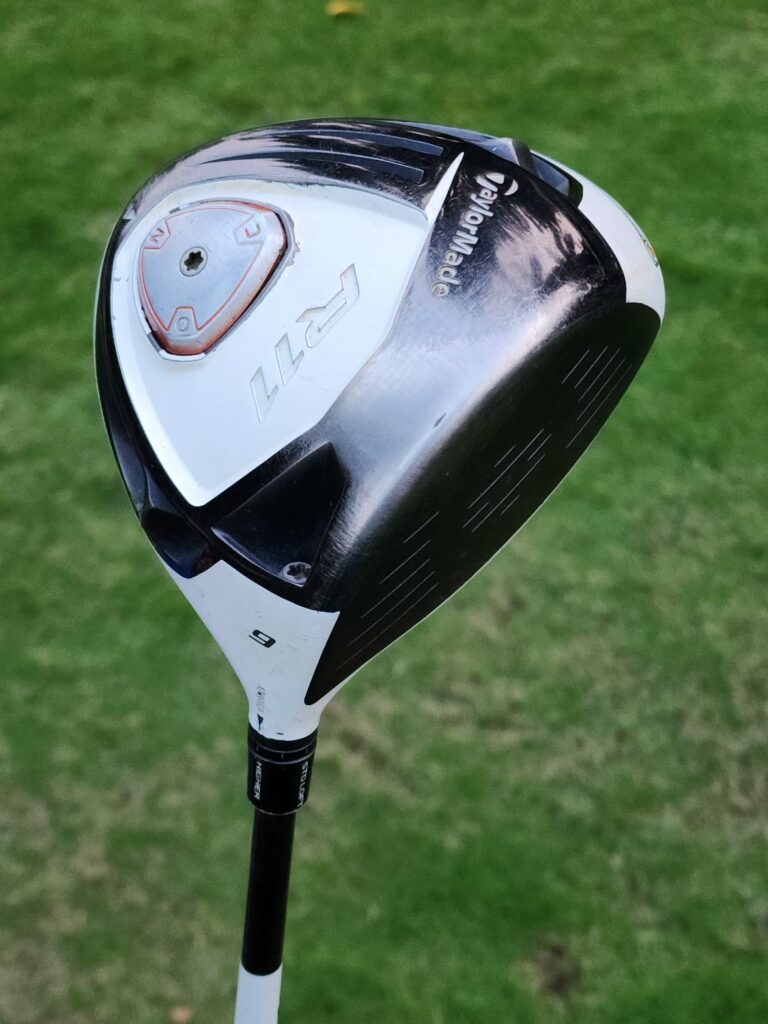
A driver with a 10.5-degree loft is ideal for high handicappers and beginners. This is why most beginner drivers and forgiving drivers have a high loft of 10.5° or above.
A higher loft driver provides more forgiveness and a higher ball flight but has more spin and less distance than a lower loft driver. Since high handicappers need to focus on hitting more fairways off the tee than getting the maximum distance, a 10.5 driver suits better.
Higher-lofted clubs are also easier to hit. This is why a 9-iron is easier than hitting a 4-iron, but it doesn’t go as far. I won’t explain each golf club’s loft since this article is focused purely on the driver’s loft.
If you’re struggling with your drives and think your driver loft is to blame, using the correct driver loft for your swing can improve your output. In most cases, you won’t need a new driver shaft either.
If you’re a high handicapper, I suggest you use a higher loft driver than the one you currently use.
You have three options if your driver loft remains too high for your swing.
- Find a driver with an adjustable hosel that lets you weaken the clubface’s loft angle in moderation.
- Consider the costly approach of customization.
- Think about a strong lofted 3-wood with 13 to 13.5 degrees of loft.
Most golfers use a 9° or a 10.5° driver, but you can also experiment with a 12-degree driver.
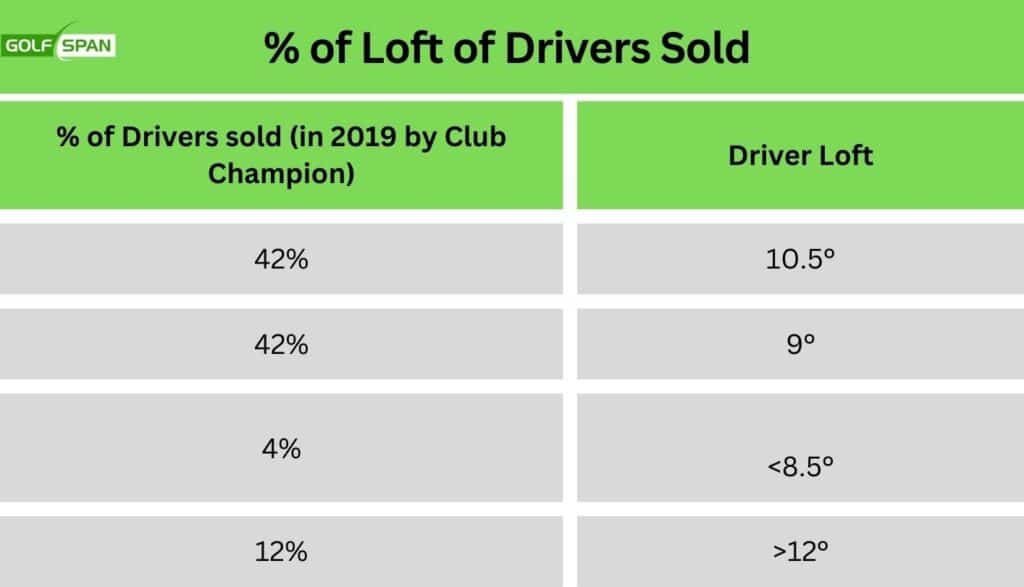
A 9-degree driver loft is most suited and commonly used by professional golfers and low handicappers.
As your golf game improves and your swing evolves (or gets faster), you must reconsider your driver loft. Low-handicap golfers want to maximize their driving distance and reduce spin.
These players are best positioned to swing a 9-degree driver for low spin, controlled ball flight, and maximum roll.
On the other hand, if you have a fast swing speed (above 100 mph) and you’re using a high-lofted driver, you might have an open-face contact, which results in a slice.
I had the same problem, and going from a 10.5 to a 9.5 driver made a difference (along with spending hours at the driving range).
It’s important to remember that a lower loft driver won’t always be better for fast swing speeds, and there’s no one best driver loft for distance. While golfers like Bryson DeChambeau stand out for having a 5-degree lofted driver , many PGA tour players also play with a 10.5-degree driver.
I’ve created this table showing the statistics of some professional golfers. This table highlights that loft isn’t the only factor when maximizing distance.
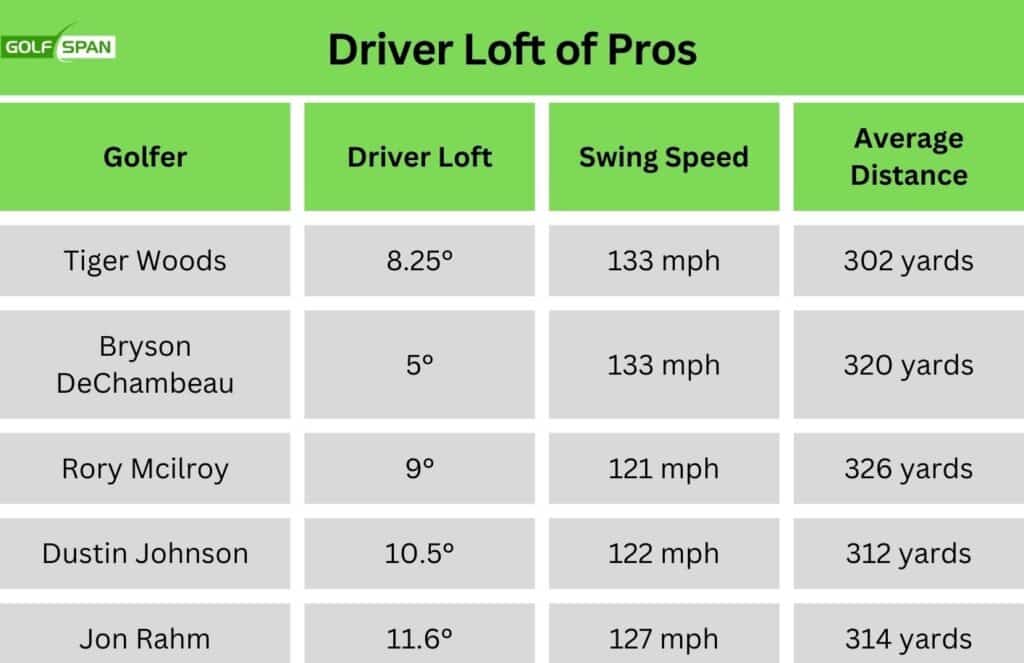
Lower Lofted vs High Lofted Drivers
9.5° or less loft is considered to be a low lofted driver. Anything above 10° loft is in the category of high-lofted drivers.
Higher lofted drivers aid most amateurs since they can improve their launch, accuracy, and spin off the tee.
If your driver loft is too low for your clubhead speed, you will produce inadequate carry, distance, and erratic dispersion.
Swinging a lower lofted driver can cause you to slice your golf shots and spend every hole in the right rough. Conversely, higher lofted drivers carry a draw bias, provoking snap hooks.
But, with faster swing speeds and high lofts, the open clubface causes you to generate increased spin, causing your ball to fly higher and follow an aggressive descent to land softly. As a result, it eradicates roll, hampering your total yardage potential.
Who Should Use a High Lofted Driver ?
Generally, a high-lofted driver is best suited for:
- New golfers
- High handicappers
- Golfers with slow swing speeds
- Golfers who can’t hit the ball upwards
- Senior golfers
Low-lofted drivers are usually preferred by:
- Golfers with a fast swing speed
- Low handicappers who want more carry distance
- Golfers who struggle with too much spin.
- Golfers that have a higher launch angle than desired
Yes, in my experience, a higher lofted driver is better for most amateur golfers, as it is easier to consistently launch your golf ball from the tee. However, a higher loft driver can cause faster swingers to generate excess spin and a ballooned shot for a loss of roll and total distance.
Golfers with higher swing speeds should use a 9-degree driver or less. Conversely, golfers with moderate swing speeds are advised to play with a 10.5-degree driver. Finally, slow swing speeds are best equipped to strike a 12-degree or weaker driver.
Yes, lowering the driver loft opens the club face angle, as shown by Mobile Clubmaker Golf in this Youtube video. You’ll notice that as he strengthens the loft, the clubface opens. Conversely, when he weakens the loft, it closes the angle of the clubface, creating a draw bias setup.

Matt Callcott-Stevens
Matt has played golf since he was 4 years old and has written over 150 articles at GolfSpan since 2021. Matt specializes in product reviews using his postgraduate degree in Sports Marketing from Johan Cruyff Institute. Matt has a handicap index of 10.8 and currently plays weekly at Pilar Golf Course near his home in Buenos Aires, Argentina. He also loves his Callaway Odyssey Exo Rossie putter and likes a pepper steak pie with curry gravy at the turn. You can connect with him on LinkedIn .
- Matt Callcott-Stevens https://www.golfspan.com/author/matt-callcott-stevens Callaway Rogue X Irons: Strong Lofts For Added Distance
- Matt Callcott-Stevens https://www.golfspan.com/author/matt-callcott-stevens Achievable Golf Goals To Lower Your Score in 2024
- Matt Callcott-Stevens https://www.golfspan.com/author/matt-callcott-stevens 15 Best Golf Clubs For Beginners: Pros & Cons
- Matt Callcott-Stevens https://www.golfspan.com/author/matt-callcott-stevens 5 Best Golf Balls for Beginners: Affordable and High Quality
You might also like these

CONNECT WITH US

What Loft Of Driver Should I Use?
Are you wondering what loft of driver is best for your game? Here, we take a look at the different factors that need to be considered
- Sign up to Golf Monthly Newsletter Newsletter
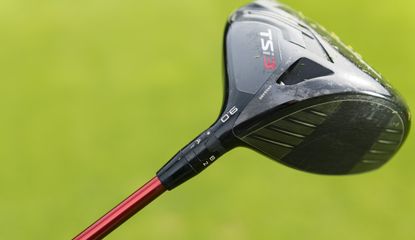
Along with your putter, the driver is one of the most frequently used golf clubs in your bag, making it one of the most important to get correct regarding set-up. If you are able to put the ball in play off the tee, then your scores will only improve.
There are a number of factors that can hinder your performance with your tee shot, one of those being loft. However, what is the correct loft that you should be using? It’s a frequently asked question and one that will vary from person to person and is dependent on a number of factors that could get very technical and in-depth.
While things like launch angle, dynamic loft and impact location are important and play a role in deciding the best loft for you, we're going to try and keep it simple. Ultimately, there's no substitute for going to see your local pro and have a hit on a launch monitor to assess your swing properly.
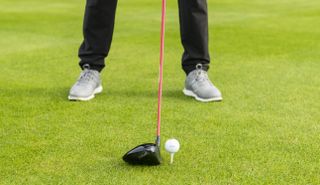
It's important that you have the correct loft for your driver
Why Will Most Golfers Benefit From More Loft?
Generally, the slower the swing or club speed, the higher the loft of the driver needs to be to optimise both carry, roll and forgiveness. However, it must be said, a higher loft won’t always work for everyone. If you do have more loft though, you are more likely to get the ball airborne off the tee.
What Is Spin Loft And Why Is It Important?
It sounds complicated, but it isn’t. The reason you need to know what spin loft is, is because it affects the amount of backspin you create, which in turn affects the distance the ball will travel.
Spin loft is the difference in angle between your attack angle (how much up or down the clubhead is traveling at impact) and the dynamic loft (the loft presented to the ball at impact).
The higher the spin loft, the more backspin you create. So, if your attack angle is downward significantly, the chances are your spin loft is quite high and you create high levels of backspin. By high, we mean above 3000 rpm. This tends to be great for accuracy, but not for distance.
Get the Golf Monthly Newsletter
Subscribe to the Golf Monthly newsletter to stay up to date with all the latest tour news, equipment news, reviews, head-to-heads and buyer’s guides from our team of experienced experts.
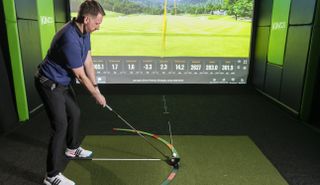
Using software like TrackMan will help find out what your spin rate is for your driver
Who Needs A High Lofted Driver?
1. Slow Swingers
Someone with a slow swing speed (85mph or less) needs more loft on their driver. Why? Well, imagine firing water from a garden hose at a plant pot on the other side of the garden. If someone were to turn down the pressure of the hose, you would have to tilt the nozzle upwards to try and maintain the distance the water is traveling. The same applies to the loft of your driver. Golfers with this swing speed would typically benefit from a driver between 12-14° of loft.
2. Upward Hitters
Golfers that hit up on the ball (have a positive attack angle) will tend to spin the ball less because their spin loft is lower. So they can therefore afford to have slightly more loft to maximise distance. However, an upward attack angle will also tend to launch the ball higher anyway, so the 'loft up' message applies slightly less here.
3. Those That Use Low And Front Weighted Drivers
Drivers that possess a low and forward centre of gravity, be it through the position of front tracks or heavier sole weights, tend to generate less spin so require a higher launch angle (created by using a higher loft) to maximise distance.
Currently on the market, there a number of best golf drivers for distance . However, it is worth noting that a higher lofted driver is also more forgiving because it is harder to curve the ball.
Who Needs A Lower Lofted Driver?
1. Fast Swingers
If you’re in this bracket (105mph club speed or more) then you probably don’t need as much loft as a slow swinger because your ball speed is sufficient to keep it traveling on the optimum trajectory. Anywhere between 8.5-10° will usually suffice. If you have a mid swing speed of 95-104 mph, a driver loft of between 10-11.5° will normally be a good starting point.
2. Downward Hitters
If you hit down on the ball, you’re likely to have high spin loft, so using less loft will actually reduce your backspin and should help you hit the ball further. However, you need to make sure you maintain a high enough launch angle in the process, above 11 degrees ideally.
3. Those That Use High And Back Weighted Drivers
Drivers with a back CG (Centre of Gravity) placement in the head naturally create a higher launch and higher spin. You therefore don’t need as much loft to get the ball airborne and keep it there. The CG also helps your strike, with an array of the most forgiving drivers now available on the market.
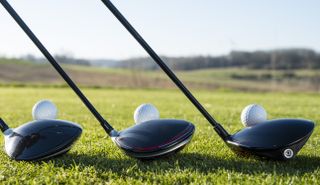
Drivers with weight towards the back of the head will naturally create more loft
Other Things To Consider…
Clubface Adjustability
If you’ve got a driver that offers clubface angle adjustment, changing the face angle can also affect the loft – unless the two work independently. When you open the clubface, you increase the loft and vice versa. So be wary of this when tweaking yours.
Dynamic Loft
Dynamic loft is the actual loft you present to the ball at impact and it can differ greatly to the loft etched on the sole of your driver. There are many factors that affect it. A downward attack angle tends to reduce dynamic loft, as does having the hands excessively ahead of the ball at impact. Remember, dynamic loft affects launch, spin and ultimately distance so have a go on a decent launch monitor to see what yours is.
Impact location
Here’s a fact for you. The loft on your clubface varies from top to bottom by up to six degrees! Loft is at its lowest on the bottom of the clubface and is at its highest on the top. Strikes above the clubface centre will tend to launch higher with less spin and vice versa on shots from low on the clubface.
Our Thoughts
As you now know, there are a lot of factors that you should consider before choosing the loft of your driver and the best way to ensure you make the right choice is to go and get fitted by a PGA professional on a launch monitor. Thanks to some of the best golf drivers , you should have no problem finding one that suits your game.
Joel has worked in the golf industry for over 12 years covering both instruction and more recently equipment. He now oversees all product content here at Golf Monthly, managing a team of talented and passionate writers and presenters in delivering the most thorough and accurate reviews, buying advice, comparisons and deals to help the reader find exactly what they are looking for. So whether it's the latest driver, irons, putter or laser rangefinder, Joel has his finger on the pulse keeping up to date with the latest releases in golf. He is also responsible for all content on irons and golf tech, including distance measuring devices and launch monitors.
One of his career highlights came when covering the 2012 Masters he got to play the sacred Augusta National course on the Monday after the tournament concluded, shooting a respectable 86 with just one par and four birdies. To date, his best ever round of golf is a 5-under 67 back in 2011. He currently plays his golf at Burghley Park Golf Club in Stamford, Lincs, with a handicap index of 3.2.
Joel's current What's In The Bag?
Driver: Titleist TSR3 , 9°
Fairway wood: Titleist TSR3 , 15°
Hybrid: Titleist TSi2 , 18°
Irons: Ping i230 4-UW
Wedges: Titleist Vokey SM8 , 54°. Titleist Vokey SM9 60° lob wedge, K Grind
Putter: Evnroll ER2V
Ball: 2023 Titleist Pro V1x
- Matt Cradock Staff Writer

Tom Kim is searching for his fourth PGA Tour victory with Scottie Scheffler and Akshay Bhatia one stroke behind heading into the final day at TPC River Highlands
By Jonny Leighfield Published 23 June 24

The American ripped TPC River Highlands apart on Saturday, as Young carded two eagles and seven birdies for a magical 59
By Matt Cradock Published 22 June 24
- Contact Future's experts
- Terms and conditions
- Privacy policy
- Accessibility statement
- Cookies policy
- Advertise with us
Golf Monthly is part of Future plc, an international media group and leading digital publisher. Visit our corporate site . © Future Publishing Limited Quay House, The Ambury, Bath BA1 1UA. All rights reserved. England and Wales company registration number 2008885.
What is Dynamic Loft?
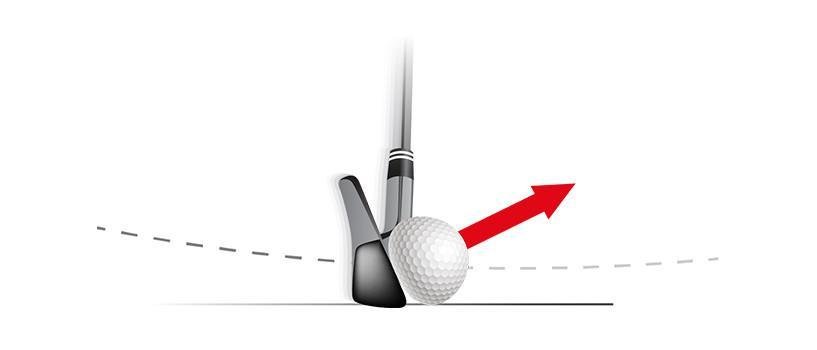
The vertical angle of the club face at the center-point of contact between the club and ball at the time of maximum compression
Dynamic loft is the amount of loft on the club face at impact and is measured relative to the horizon..
The golfer’s attack angle, how the shaft bends, how the golfer releases the club head, whether the club face is open or closed to the club path, and where the ball makes contact on the club face can all affect the dynamic loft.
Creating the proper dynamic loft is important to creating the optimal trajectory and maximizing carry. Too much dynamic loft can send the ball too high into the air and reduce the golfer’s distance. Too little dynamic loft can send the ball too low making the ball roll out excessively causing it difficult to judge distance.
Technical Definition:
Dynamic Loft – The vertical club face orientation at the center-point of contact between the club face and golf ball at the time of maximum compression
[separator] [one_half]
Tour Averages
- Driver – 12.8 degrees
- 6 iron –20.2 degrees
- Driver – 15.5 degrees
- 6 iron – 23.6 degrees
For a full list of Tour averages, visit TrackMan PGA and LPGA Tour Averages [/one_half] [one_half_last]
TrackMan Combine Averages
Male Amateur (Driver)
- Scratch of Better – 13.0 degrees
- 5 HCP – 13.2 degrees
- 10 HCP – 14.1 degrees
- Average Golfer (14.5) – 15.1 degrees
- Bogey Golfer – 14.3 degrees
Female Amateur (Driver)
- Scratch or Better – 14.8 degrees
- 5 HCP – 14.4 degrees
- 10 HCP – 15.0 degrees
- 15 HCP – 16.5 degrees
Learn more about TrackMan Combine, visit TrackMan Combine Explained [/one_half_last] [separator]
The standard assumption for dynamic loft comes from the TrackMan Optimizer. For the driver, a club speed of 94 mph, attack angle of 0 degrees, and optimized carry results in a dynamic loft of 15.6 degrees. For a 6-iron, a club speed of 80 mph and mid-trajectory results in a dynamic loft of 22.4 degrees. For a PW, a club speed of 72 mph and mid-trajectory results in a dynamic loft of 36.7 degrees.
What our TrackMan Masters say about Dynamic Loft…
[one_third]

Andrew Rice Berkeley Hall Golf Club, SC, US
“Dynamic loft often will show me what a golfer is capable of, as better golfers seldom hit shots with too much dynamic loft.
Learn to de-loft the club face into impact and you are well on your way to being able to compress the golf ball” [/one_third]

Christoph Bausek Progressive Golf, Austria
“Dynamic loft is a very good indicator of whether a golfer is adding too much loft or de-lofting the club too much.
But be careful with drivers…hitting the ball high on the face will create a higher dynamic loft due to the roll of the club face.
Dynamic loft is the main factor for launching a ball into the air. There is a myth that “hitting down on the ball gets the ball up”.
Instead, pay attention to the dynamic loft if you want to get the ball up.” [/one_third]
[one_third_last]

James Leitz Pinewood Country Club, LA, US
“I call dynamic loft “delivered loft”. Most golfers’ dynamic loft is too high for a particular club and therefore their launch angle is too high.
The key is to teach the golfer to deliver a lower dynamic loft without increasing their attack angle, especially with irons.” [/one_third_last]
I recently took the level 2 certification test on line and made a mistake answering this question not choosing A as an answer. Is there anybody out there able to explain to me why when talking about dynamic loft, how the static one might be relevant ? I don’t get it. I can start a golf swing with any static loft and the dynamic one at impact can be about the same, higher or lower, right ? So… ?
Thanks for your answer but I found the question ambiguous…
) Dynamic Loft is comprised of the following variables. Select 5 out of 6 answers Value Score Choose one answer. A) Static Loft 1 0 B) Any lead/lag of the shaft at impact 1 0 C) Roll on club face if not impacted in center 1 0 D) Left arm/shaft angle 1 0 E) Attack Angle 1 0 F) Tee height
Hi Patrick,
The static loft is relevant because it is setting the starting point / basis for for the dynamic loft. It can be changed in the formula, just like the other parameters also can be changed and will affect the dynamic loft.
Feel free to get back to me on [email protected] if you have any additional questions or comments to this or any other question.
Thank you Niklas Bergdahl Support Manager Europe & Asia
Leave a Reply Cancel reply
Your email address will not be published. Required fields are marked *
- Coach Of The Month
Recent Comments
- Dylan Maki on TrackMan Average Tour Stats
- Magnus Lundstrøm on Dustin Johnson – 2017 WGC Mexico
- Mark Rippy on Brooks Koepka, winner of the US Open 2017 and 2018
- Pete Player on How The TrackMan Optimizer Works
- Coach of the month

Selecting the Correct Driver Loft
Photo via @digital__jedi
Bombarded with the countless drivers that hit the market on a regular basis, we’re often all to quick to rush and purchase one based on flashy commercials and promises of more yards and better accuracy. But, do you ever really put enough thought into finding your correct driver loft?
Odds are you don’t, and that’s nothing to be embarrassed about. In truth, loft is one of the most misunderstood aspects of selecting a new driver.
The market is flooded with drivers that range between 4-20 degree lofts with the most common lofts ranging between 9 and 11 degrees. However, what is good for one player’s swing may not work for another. In fact, there are quite a few factors that go into determing the correct driver loft for your individual game.
So in order to determine your ideal driver loft, you have to first start by correctly assessing your swing (something that can be done at most golf stores). That said, here are a few steps to help you determine the appropriate driver loft degree.
Assess Your Swing Speed
First, try to assess the speed at which you swing your driver. This can be done by visiting the local golf store and using one of their demo club/club fitting simulator screens. If your pro shop or local golf store doesn’t have a simulator to do this you can also use a tool like the SwingTIP to measure swing speed on your own.
If none of this equipment is available to you, there are also inexpensive swing speed apps that you can download right to your smartphone to get a general idea of your driver swing speed.
Once you know you’re swing speed the next step is knowing how it relates to driver loft. Generally speaking, if you have a low swing speed, then the higher loft driver is for you, and vice versa. The reason for this is because the greater the club head speed, the more backspin is imparted to the ball, and therefore less loft is required for best trajectory.
The average touring professional has a swing speed of 113+ mph and the average driver loft on tour is around 8.5 degrees. This combination of high swing speed and low loft is the reason you see them averaging 300+ yards per drive. Alternatively, the average amateur golfer will have a swing speed somewhere between 60 and 100 mph (depending on gender, build, skill level, and many other factors). If you fall in the 70 mph or under range, it’s best to select a driver with a loft of around 18-19 degrees (similar to a 5-wood). Most average handicap golfers will have a swing speed of around 80-90 mph and would benefit from a driver loft of anywhere from 10-12 degrees. If yourswing speed is 100 mph or more you can often step up to a driver with less than a 10 degree loft (9.5 degrees is quite common in this swing speed range).
But swing speed isn’t everything. No matter what your swing speed you have to make sure you’re playing with a loft that you’re comfortable with, and one that gives you the greatest possible consistency.
Swing Consistency
Speaking of consistency, a lower lofted driver will increase the side spin at impact when the club face is open or closed, making it much harder to control a lower lofted driver. This is important to keep in mind because any inaccuracies or deviance in your swing path is going to be dramatically amplified if you use a lower lofted driver. For this reason, even players with incredibly fast swing speeds should still consider going with a slightly higher lofted club if they struggle with inconsistencies in their ball flight. A higher loft will help to eliminate at least a portion of the side spin that results from these errant swings.
After assessing your swing speed and considering your swing consistency take some time to compare the feel of drivers within the loft range you’ve selected. You’ll see a significant difference with very slight loft changes. Whether it be more inconstant flight paths, longer carry, more pop-ups, etc., look for trends to develop within each loft, try to find one that feels right and creates the trajectory you desire most often, and, if possible ask the pro to assist you to determine which is right.
Keep in mind that shaft stiffness and torque should be the same for each club face you are comparing to ensure that your comparison is consistent.
Lee Westwood Tips: Getting FIt Into The Right Driver No Description
Keep in mind that swing speed is the main factor in determining which loft is appropriate for you. Stop by the local golf store, grab a few drivers and ask the pro in the store to help measure you speed. Once you determine the mph associated with your speed, you can easily begin to narrow down a loft range that’s right for your game.
( Cover Photo Credit )
Best Apps to Watch Golf on Your Smartphone
3 Up Golf Ball Review – The 3F12
Fantasy Golf Picks, Odds, and Predictions – 2024 Rocket Mortgage Classic

Penfold Golf Combines Class and Luxury with Simplicity
LIV Golf Nashville Recap: Hatton Is First-Time Winner as Rahm Fumes Over Drone
Here’s (Roughly) How Much Scottie Scheffler’s Caddie Has Made in 2024

Scottie Scheffler Wins Six Times Before July — A Feat Not Done in Over 60 Years
Padraig Harrington Had Nothing But Good Things to Say About This LIV Golfer
Paige Spiranac and Others Fire Back at Brandel Chamblee Bias During U.S. Open
Juicy New Image of Rory McIlroy and Amanda Balionis Has the Rumor Mill Churning

Vice Golf Debuts Irons, Wedges, and Putters

Golfer Makes Hilarious Entrance at Local Member/Guest in Honor of Scottie Scheffler

We Played This Old Golf Course Where Thomas Edison Was A Member

Are You MEASURING Your Golf Swing Correctly? (This Can Help)

Zach Johnson Explains Why He Didn’t Pick Bryson DeChambeau for the Ryder Cup

Justin Thomas FIRES Coach before Ryder Cup…Who’s Next?

What Nobody Tells You About Great Ball Striking

Fantasy Golf Picks, Odds, and Predictions – 2024 Travelers Championship

Protestors Storm 18th Green as Scheffler, Kim Battle for Travelers Championship Crown
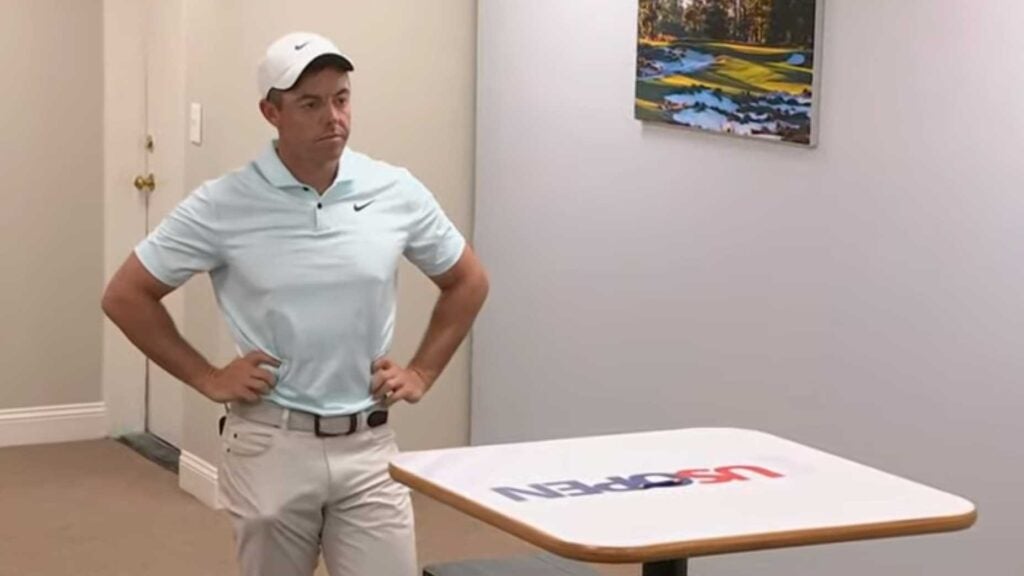
This CRAZY Rory McIlroy Stat Makes U.S. Open Putting Slip Up Even More Shocking

Rory McIlroy Breaks Silence After U.S. Open Heartbreak, Says He’s Stepping Away from Golf

Bethpage Fighting Back the Machines and Raiders

TaylorMade Launches MG4 Raw Tiger Woods Grind Wedges

Bryson DeChambeau’s Winning U.S Open Secret

What Loft Driver Should I Use? Everything You Need To Know
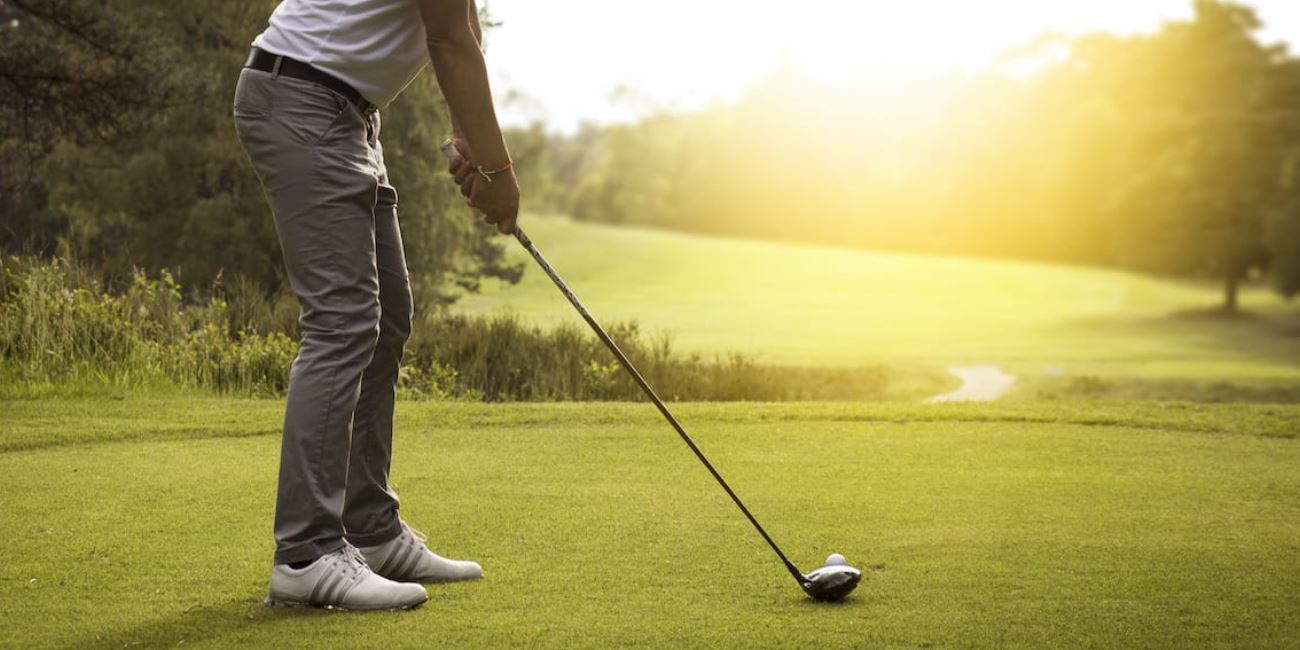
When you purchase a driver, you need to make sure that you are choosing the proper loft for your game. A golf driver with the wrong loft can make it very difficult to get both ball speed and distance from your shots.
With the proper driver loft, you can get the performance you need from a club. Finding that perfect loft can take a bit of time and patience. You may need to work on a few different lofts and do some testing to find the best one.
We have put together some of the most important things to consider when choosing a driver based on the loft.
Introduction To Driver Loft

Starting off in golf as a junior, I was using one of Dads old drivers and needless to say, it was very difficult to get off the ground and when I switched to a proper fitted set of clubs, I improved dramatically off the tee.
Junior golf drivers almost always come with a very high loft. The loft is usually 13 degrees or more. As a young aspiring professional, I always found this a bit too much.
The reason that junior drivers are built with the high loft is to accommodate those with slower swing speeds. However, not all Junior golfers have these lower swing speeds, which is why it is so important to get a driver lofted to you particular needs.
Golfers that are looking for what loft driver they need are going to have to pay more attention to the detailed specifics about their individual game than just choosing an option based on what is available on the market.
As I grew older and my swing speed increased, I also moved from a 12.5 to a 10.5 degree loft in my driver which was a natural progression, that can also happen just by improving your swing mechanics and speed naturally over time.
How Important Is Loft For Your Driver
The loft of your driver is one of the most significant factors to consider when purchasing a club.
If you choose a club with the wrong loft, you will continually struggle with both distance and forgiveness.
How Does It Affect Performance
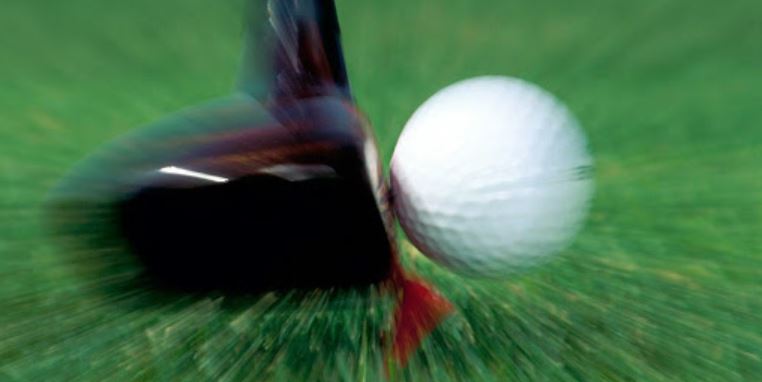
If you play with a driver that is too high lofted for you, then you will miss out on distance.
If you play with a driver that is too low for you then you will also miss out on distance.
The distance is impacted both by drivers that are too low lofted and too high lofted.
This should help to show you how important it is to find that perfect driver loft. In addition to distance, you must also consider forgiveness.
A driver with more forgiveness is going to have a higher loft. Therefore golfers that need forgiveness in their club need to choose something that has plenty of lofts.
What Is The Main Factor That Goes Into Determining What Loft To Use?
The main factor that determines what loft you should be using in your driver is swing speed.
The faster your swing speed, the lower the loft you can play with.
Golfers with high swing speeds have the ability to launch the ball high because of the spin that they create.
If you do not have a high swing speed, you are going to need to keep the loft down, so you don’t hit a ballooned type golf shot.
Slower swing speed players struggle to launch such a lower lofted club, and that is why they do better when given a driver with 13 or more degrees of loft.
Are There Other Factors Besides Swing Speed?

Aside from swing speed, it is also important that golfers pay attention to the natural tendencies of their swing.
Do you have a tendency to hit line drive shots or hit high fly balls?
There are many different types of golf swings and player capabilities. There are options on the market that will work for all players; it just takes a bit of time to find them.
The shaft weight can also impact the height that a golfer can hit the ball.
IF you are struggling with hitting the ball too high and your loft has already been turned down quite a bit, then the best choice could be to put a heavier golf shaft in place or slightly lower your loft.
What Type Of People Should Use A Higher Lofted Driver?
Beginners and higher handicap golfers with slower swing speeds are going to benefit greatly from a higher lofted driver.
It is best to purchase a higher lofted driver that is adjustable. This way, as you improve, you can change the loft on your club to match your swing.
What Type Of People Should Use A Lower Lofted Driver?

Lower lofted drivers are for the golfer with the fastest swing speeds.
If you swing more than 100mph or more, you are going to need a driver with a lower loft.

Swing Speed Vs. Driver Loft Chart
What driver lofts do the pros use.
Most professionals on the PGA golf tour are using a driver with a loft between 9 and 10.5.
The golfers will change the loft based on the shaft they have on their club and how the shaft impacts the ball flight as well.
Most golfers on the professional circuit have a very fast swing speed. These high swing speeds lead the players to need more decreased driver lofts.
Lowest On Tour
Some golfers on the PGA Tour can get a little extreme when it comes to driver loft. One such player is Bryson Dechambeau.
The loft that Bryson plays with is 5.5 degrees. With 5.5 degrees of loft, it’s amazing the launch that he can still get from his drives.
Most amateurs would never be able to get a 5.5-degree driver off the ground.
What Loft Should Women Use?
Women golfers typically have between 13 and 16 degrees of loft in a stock woman driver.
If a woman golfer has a slower swing speed, this is a perfect amount of loft.
However, for women with faster swing speeds, this may not be enough loft to make it really a good fit.
The faster-swinging women golfers should use something with 12.5 degrees of loft or less.
What About Seniors?
Senior golfers will notice that their swing speed starts to slow down a bit. This is natural and to be expected with senior golfers.
If you notice that your swing is starting to slow down more than usual, it could be time to increase the loft in your driver.
Most senior golfers are going to do best with a loft around 12 to 14 degrees.
This tends to give the best balance of both distance and forgiveness in the club.
What If I Am Hitting The Ball Too High – What Should I Do
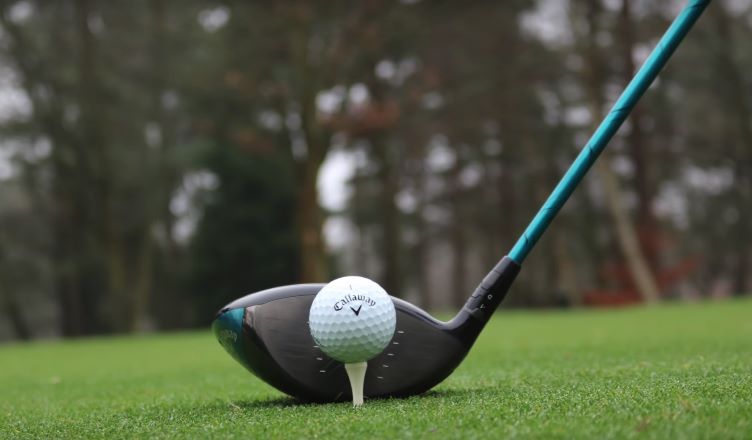
If you find that you are hitting the golf ball too high, it is likely time to look for a driver with a lower loft.
If you don’t want to purchase a new driver, you can sometimes add weight to the golf club or stiffen the golf shaft to be able to hit the ball a bit lower.
What If I Am Hitting The Ball Too Low?
Hitting the golf ball too low can be very frustrating. When the ball is too low, the distance you can get is extremely impacted.
You will end up getting plenty of roll but not enough launch and ball flight. When drivers don’t have enough loft, you may also notice that you can’t get the ball heading to your target the right way either.
Many players tend to hit a slice with a driver that is too low. The best thing to do is to adjust your driver to a higher loft or purchase one that is a better fit for your game.
Can Driver Loft Affect A Hook Or A Slice?
If your driver does not have enough loft, you are going to notice that you have a hard time keeping the ball straight.
The lower lofted drivers are much less forgiving, and those with slower swing speeds often have a hard time hitting them straight.
Sometimes a slice is caused by a player incorrectly swinging at the ball, but it absolutely can be related to the equipment as well.
Does Tee Height Affect Driving Distance?
Lining your golf tee up at the perfect location is very important. If your golf tee is too low or too high, you could miss the sweet spot as you hit your shots.
If you miss the sweet spot, your drives are not going to be nearly as long as they could be.
Always check to make sure that the tee height of the golf ball allows you to hit the drive directly in the center of the golf driver.
Who Should Swap Their Driver For A 3 Wood?
Sometimes golfers continue to struggle with their driver.
It can sometimes mean that you are hitting shots that are too low or too left, but there is just no confidence in these golf shots.
If you have tried with a driver for quite some time and have had no results, the 3 wood may be a better choice.
Although you will lose a bit of distance switching to a 3 wood, the results are going to be well worth it.
What’s The Best Way To Ensure Correct Loft In Your Driver?
The best thing a golfer can do when it comes to choosing a driver based on loft is to choose an adjustable loft.
Adjustable loft makes it much easier to change your loft and adjust as necessary.
You may find that you are playing great at 11.5 for a while and then notice that your game really needs 10.5.
This adjustable driver gives you that option without having to replace your driver.
Best Driver – Mini Reviews With Pros And Cons
Best choice: callaway mavrik driver.
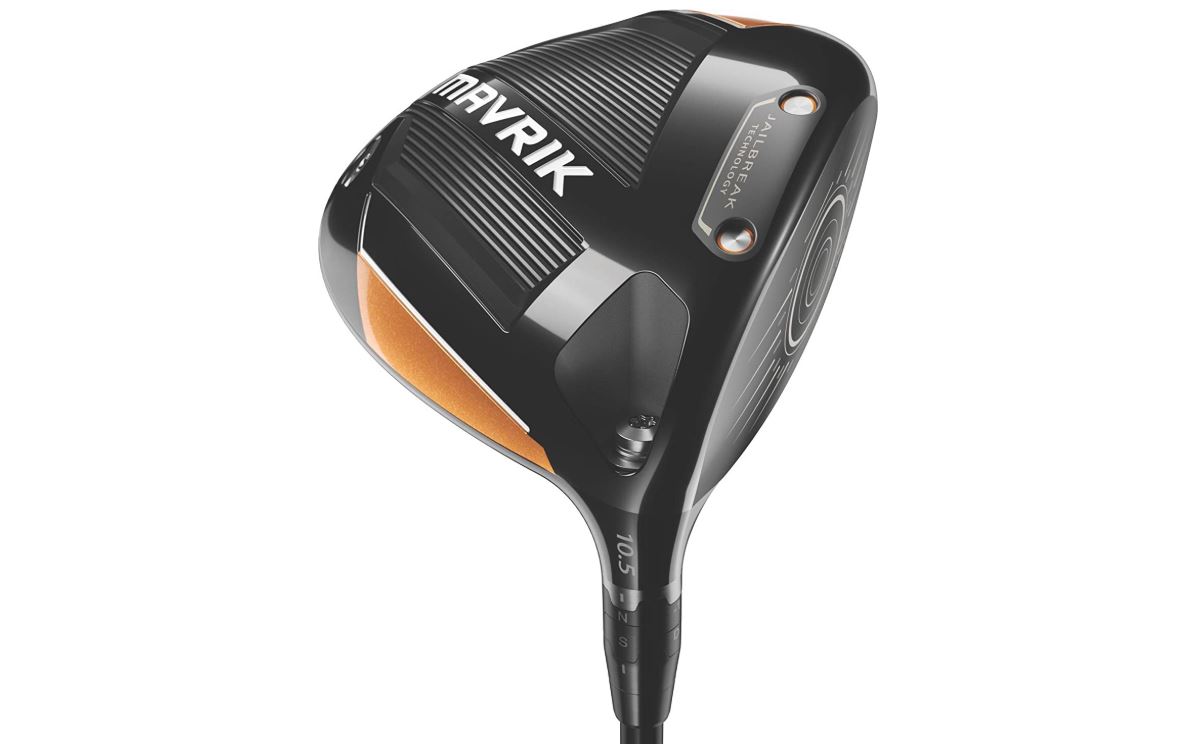
The Callaway Mavrik Driver is one of the best choices on the market for loft adjustability.
You can set the Mavrik to work for your individual needs for your game and get the results you need.
We love that the Mavrik is so naturally long and has an excellent feel when you hit it.
- One of the faster clubs faces in golf
- Easy to launch
- Long-distance and adjustability
- Tinny sound at impact sometimes
Overall Score: 96/100
Check out more reviews here:.
Best For Slow Swingers: Cobra Speedback Driver

The Cobra Speedback driver is highly adjustable and built for speed.
If you are a golfer that struggles to get the ball in the air and to hit it a long distance, the Speedback is going to be a very smart choice.
This driver has drooped in price through the years and now comes at a very fair value.
- Good pricing
- It helps slower swing speed players get distance
- The adjustability range is wide
- Not as long as the Speedzone when perfect contact is made
Overall Score: 95/100
Best for fast swingers: taylormade sim 2 max.
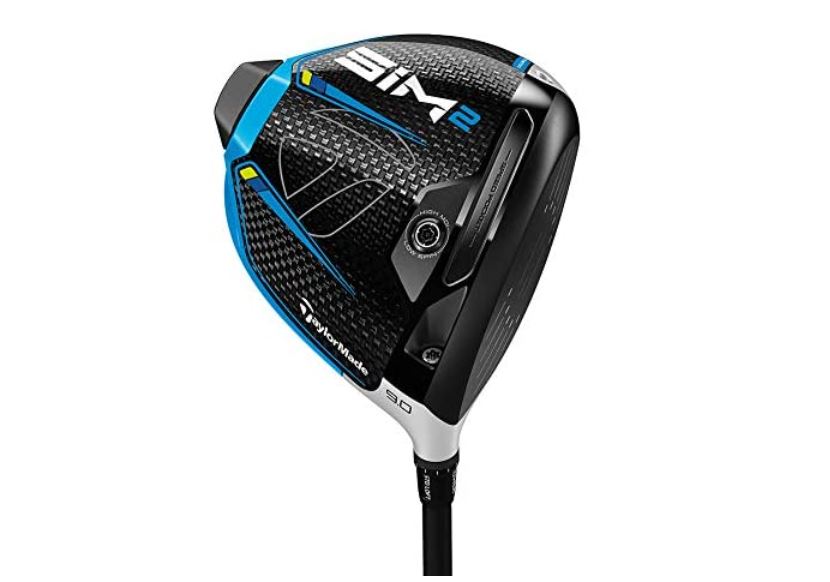
The TaylorMade SIM 2 Max is going to be a very fast and forgiving driver.
This driver is built for speed, and those with the fast swing speeds will love the results that they can get with this club.
The SIM 2 Max driver is a high speed and easy to adjust for the proper loft.
- Long distance
- High ball speeds
- High priced new club
Overall Score: 98/100
As you can see, driver loft is a very important factor when you are choosing a golf club. If you choose a driver loft that is not right for your game, you will struggle with distance, launch, and forgiveness.
The higher you can launch the ball and send it down the fairway, the longer you are going to be able to hit the ball. For most players, this ideal loft is going to be around 10.5 degrees.
However, if your swing speed or player profile is not in the average range, you need to consider both higher and lower lofted golf driver loft options.

Hi, I am Matthew, a mid handicap golfer who likes to play as much as possible. I love trying out new gear and this blog is where you can find all the gear I have tested over the years!
Share this post:
© 2024 Amazon Associates Program. Southampton Golf Club is a participant in the Amazon Services LLC Associates Program, an affiliate advertising program designed to provide a means for sites to earn advertising fees by advertising and linking to Amazon.com. *Amazon and the Amazon logo are trademarks of Amazon.com, Inc., or its affiliates.
Product Reviews
- The Garmin S62 vs The S60 – There Is A New Sheriff In Town
- Nikon Coolshot Rangefinder Review
- FORB Home Golf Putting Mat Review
- Garmin Approach S60 Premium GPS Golf Watch Review
- Putt-A-Bout Indoor Putting Green Review
- All Golf Equipment Reviews
- Privacy Policy
TOP 10 LINKS
- Best Beginner Golf Club Sets 2023 – The Ultimate Golfing Resource
- Best Golf Rangefinders 2023 – For Pin Seeking Golfers
- Top 15 Best Golf Gadgets 2023
- Best Golf Push Carts 2023 – Navigate The Course With Ease
- Best Golf Travel Bags 2023 – Arrive In Club Protecting Style
- All Golf Top 10 Best Product Lists
Golf Buying Guides
- Definitive Buying Guide For Golf Balls
- Golf GPS Watch Buying Guide
- Definitive Guide To Golf Rangefinders
- Ultimate Golf Gifts Buying Guide For 2023
- Golf Bag Buying Guide
- Golf Club Shaft Flex Guide

What Every Golfer Needs to Know About Their Driver Loft

Britt O has been playing golf since the age of 7. Almost 30 years later, she still loves the game, has played competitively on every level, and spent a good portion of her life as a Class A PGA Professional. Britt currently resides in Savannah, GA, with her husband and two young children. Current Handicap: 1
View all posts by Brittany Olizarowicz
Do you know what the loft of your driver is? Do you know if it’s the correct loft for your golf game?
Loft is kind of a misunderstood concept in the game of golf, and we are here to clear that up. Most modern golf drivers have an adjustable loft, therefore making it easier to fine-tune the performance that you need.
Whether you are a beginner or a more accomplished player, you will still need to understand what loft in the driver is and how it will impact your golf game.
What is The Loft on a Driver?

The loft is the angle of the clubface of a driver. Most drivers have a loft between 8 and 13 degrees. The 8 degree driver will have a much lower launch than the 13 degrees, and it will also impact overall distance and forgiveness.
Many players think that the loft on the driver will impact only the launch angle of your golf shot, but there is quite a bit more to it than this.
How Driver Loft Affects Your Ball Flight
The interesting thing about the loft of your driver is that it is not just about how high you hit the golf ball. In addition, the loft will help you with distance, accuracy, and forgiveness.
The total distance of the golf shot is impacted by the club’s loft. One of the myths of the game is that when you can keep the ball lower, you will get more distance. For some golfers, a lower lofted driver does maximize distance, but that is more about their path and their speed than the driver.
Many professional golfers can hit a driver with 8 degrees of loft and get it to fly 300 or more yards. When you watch the ball flight of this drive, it is still quite high. The higher lofted shot allows the ball to stay in the air for quite some time. The air provides less resistance than the ground.
However, slower swing speed players often struggle to get the distance they need with the lower lofted driver. The lower a loft gets on a golf club, the harder it is to get the ball up off the ground.
High lofted drivers that are 11 or 12 degrees offer great distance for the slower swing speed players.
Forgiveness
In addition to golf driver loft impacting distance, it will also impact forgiveness. The forgiveness of a golf driver is considerably higher when it has a higher loft. The higher the loft, the easier it is to get the ball straight down the fairway.
You may be wondering why golfers don’t want to use higher lofted drivers all the time.
The reason here is that for certain swing speeds, you will eventually hit the ball so high that it costs you the distance.
Golfers need to find that perfect combination of loft and launch angle to ensure maximum distance. Luckily with modern fitting equipment, this is easier than it ever has been.
I have always played with a 10.5 degree driver. Most recently, I tried to adjust the loft down to 9.5 to see if it would give me a more piercing ball flight, something that I thought would be helpful.
The ball flight was more like what I thought I needed, but the total distance from my golf shot was lacking. This just further proves the point that the best loft is the one that works the best for your speed and your angle of attack to the golf ball. For me, that is 10.5 degrees of loft.
Forgiveness and accuracy can go hand in hand. When golf drivers are the right loft for your swing speed, you should have an easier time controlling them. For instance, a player may find that with an 11 degree driver, they can be more accurate than they can be with a 10 degree driver.
The way to fine-tune this is to test your accuracy while setting the club to several different lofts.
You will quickly be able to see that at certain lofts, the slice and hook start to come out. The club feels considerably less forgiving, and your dispersion rates increase. Better players can hit their drives within a few yards of a target.
I found that the difference between swinging a 9 degree driver and a 10.5 was enough to make the sport incredibly frustrating !
How Much Difference Even 1 Degree of Loft Change Can Make on a Driver
When I’ve tested the difference that one degree of loft change makes on a driver, I’ve found the results to be within 3 to 5 yards. Where you really see the difference is when a player who was using a 12 degree driver switches to a 10 degree driver.
If you are not careful about this, you could see differences of up to 10 yards, which significantly impacts the approach shot you will have to the green.
PGA Tour players will tell you that in addition to the difference that loft makes in their shots, it is also crucial to consider the shaft in the club. The shaft can increase launch, have an impact on spin rates, and even make it so that you have a faster swing speed.
Is a Higher Loft Driver Better?
A higher lofted driver is almost always better for a golfer with a slower swing speed. When you use a higher lofted driver, the ball will stay in the air considerably longer. With a golf ball that has plenty of time in the air, you almost always see more distance.
However, if you are a fast-swinging golfer that has a steep angle of attack, the higher launch angle can create problems in your game.
You may notice that the ball goes too high, and when it lands, there is almost no forward roll. This is where you will need to work on lowering the ball flight a bit by adjusting the loft or the angle of attack.
How to Figure Out What Loft You Should Be Using on Your Driver
Now that you can see how important it is to have the right loft in your golf driver, let’s take a look at a few ways you can determine if your golf driver loft is correct.
Go to a Golf Club Fitting
A golf club fitting is a great way to narrow down which golf club driver loft could be best for your golf game. When you go to a fitting, you will work with a professional that gives you information on the perfect angle of attack and the way that impacts the actual loft of the club.
With a golf club fitting, you will tap into some great technology but also the advice of a fitting professional that understands the science of the game.
I like to go for golf club fittings where I can see the tee shot. Even though simulators are incredibly accurate, there is something about seeing the complete ball flight that makes it easier to pick the proper loft for the driver.
Get a Portable Launch Monitor
If you don’t want to go for a fitting, you can always conduct your own! Portable or personal golf launch monitors have come a long way and are now more affordable than ever. For less than $500 , you can hit golf balls on the range and get some accurate information about the shots you are hitting.
Portable launch monitors may give you less information than you get during a complete custom fitting, but this is a great place to start.
I like to hit 5 shots with a certain loft and collect measurements, and then switch to another loft and collect some more data. You will quickly be able to see which golf club is the one that could work for you.
Test It Out The Old School Way
If technology is just not your thing, feel free to pick a target on the range and experiment with different lofted drivers to see which gives you the best results.
I highly recommend testing on the course and the range so that you get a better idea of how the ball spins and how accurate it is. Sometimes, with a wide driving range, we assume the strike was relatively good, but it’s just a bit off. The golf course gives us more accurate results.
Use an Arccos Grip
The Arccos Grip may be something you already have in your golf club. Many Ping and Cobra clubs have this grip in place, and it will essentially track information about your drives as you play.
With the Arccos Grip, you can experiment with different driver lofts and get concrete evidence as to which is the right fit for your game. These grips work for slower swing speeds, average swing speed golfers, and even fast swing speeds.
The grip is less accurate than something like a Trackman golf simulator , but it’s a good step toward getting you some information.
Leave a Reply Cancel reply
Your email address will not be published. Required fields are marked *
Save my name, email, and website in this browser for the next time I comment.
Brittany Olizarowicz

Golf Workout Program is reader-supported. When you buy through links on our site, we may earn an affiliate commission.
Recent Posts
- The Must-Know Pros and Cons of a Strong Golf Swing
- 5 Best Golf Balls for People with Slow Swing Speed
- How to Play Wolf (The Golf Game) & Tips to Win
- The 5 Best Toe Hang Putters of 2024 (Pros & Cons of Each)
- 25 Awesome Golf Stocking Stuffers Under $25
- Pulling Your Irons to The Left? Here Are Some Reasons Why
- What is Lag Putting? +Tips to Improve This Part of Your Game
- The Must-Know Pros and Cons of a Closed Stance in Golf
- 3 Hybrid vs 7 Wood: How to Pick The Right Club for You
- Callaway Diablo Review – Who Is This Golf Ball Ideal For?
- Skip to primary navigation
- Skip to main content
- Skip to primary sidebar
- Skip to footer
Golf Cart Report
#1 Rated Golf Cart Consumer Guide
What Loft Driver Do Pros Use? (Everything To Know)
May 19, 2021 by Brittany Olizarowicz Leave a Comment

Professional golfers are very picky about the equipment that they use in their games.
When you consider the amount of money that they have on the line, this should come as no surprise.
One of these considerations that is quite important is the loft of the driver.
With the loft of the driver changing, golfers can get varying ball flights and fine tune them to work for their golf game.
The general thought is that professional golfers use a very low loft on their drivers, but this is not always the case.
What Loft Driver Do Pros Use?

Professional golfers tend to play with a driver that has about 9.5 degrees of loft.
Of course, there are some golfers who find 10.5 or 8.5 to be more effective, but you will generally see most players end up in the 9 to 9.5 range.
The loft on the driver makes it easier to launch.
However, most players who are on professional golf tours do not need much help learning to launch the ball high.
The ultimate goal of these players is to try and get the most distance.
Distance requires a great combination of factors in order to maximize it.
Players need to make sure that their drives are not going too high or too low.
There are some general misconceptions about the driver lofts that we see on the PGA Tour.
Many players believe that hitting a driver low is going to help it cut through the air and get more distance.
This is really not the case.
Let’s look at some of the things you should know about loft before choosing a driver.
These are all things that the professionals must consider when they choose which clubs to put in their golf bags.
How Does Loft Help A Driver Go Further?

When you think about the ball cutting through the air, you may consider that a line drive-type ball flight will be the best way to get this done.
Those flights always seem to be more powerful and take a more direct line to the target.
Although this is partially true, it is also important to consider that the longer a golf ball stays in the air, the further it is going to go.
Golf balls that stay in the air for a long time are going to travel further.
This means that in addition to the speed at which the ball is hit, the flight of the shot is also going to make a difference.
Essentially, a driver needs to travel a bit higher with an arc to stay in the air as long as possible.
Golfers who were playing the game with drivers that have 6- and 7-degree lofts have since changed to the 9- and 10-degree options.
They now realize that the ball spending a bit more time in the air is going to translate directly into more distance.
Golfers who want to hit the ball a long way should seriously consider what loft they are getting in their driver.
If you make a mistake with this choice, you will typically have a hard time getting this driver to work for your game.
The slower swing speed golfer who tends to struggle with distance may need a driver with a bit of extra loft.
These players are the ones who struggle to get the ball in the air at all, and obviously, that will decrease their distance altogether.
Loft makes a driver more forgiving, and the higher your handicap is, the better you will likely do with a higher lofted driver.
What Loft Does Bryson DeChambeau Use?
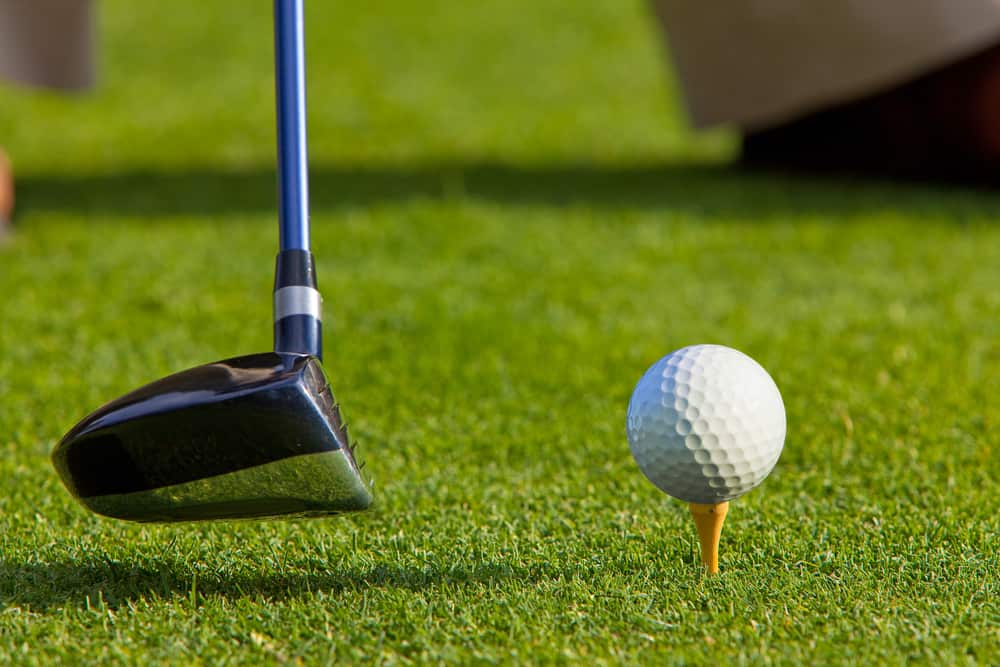
Bryson DeChambeau has made quite a name for himself on the PGA Tour in the last few years.
Bryson is known for his incredible power and distance.
When you watch Bryson swing, it is a bit different than watching other professional golfers.
He goes after the ball with a much different force, and indeed, he looks like one of those long drive champions when he goes after his shots.
The loft that Bryson uses on his driver is only 7.5 degrees.
He is very invested in science and stats and has done quite a bit of research to figure out which loft is the best fit for his game.
Having a club with only 7.5 degrees of loft can take a bit of getting used to, but it seems to work for Bryson.
There are some recent studies that have been done that are starting to question how efficient Bryson’s swing really is.
Although he has a lot of power, is that power effectively converting to yardage for him?
The results are pretty interesting, and they are showing that the effort that Bryson puts into his shots may not be all that effective.
Only time will tell if he decides to ease up a bit and actually ends up seeing some extra distance.
Until then, we are going to see Bryson going after the ball with a very low lofted driver.
How Do I Know What Loft My Driver Should Be?
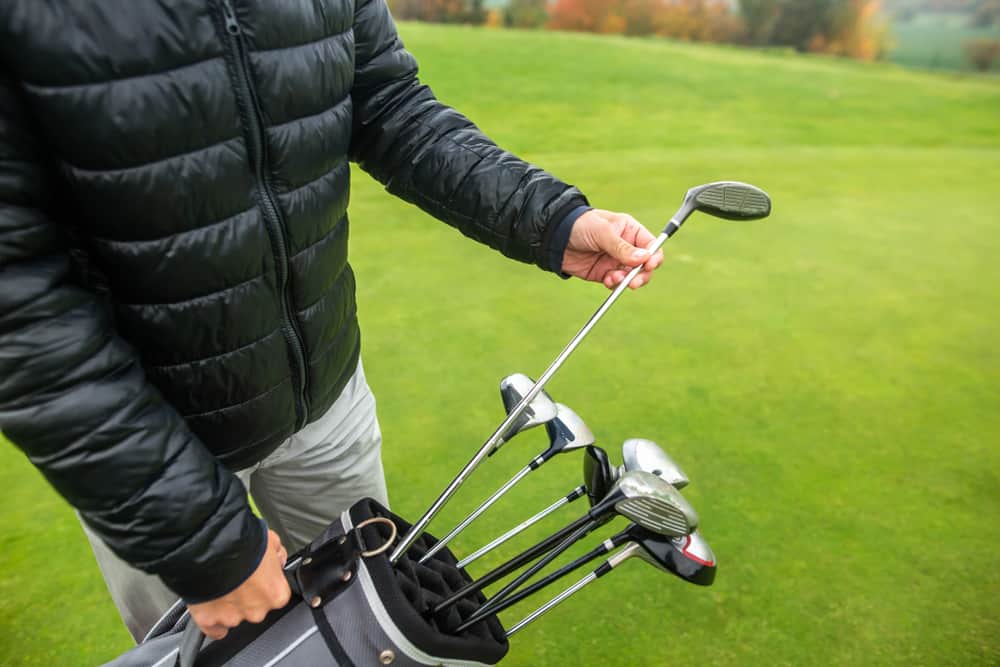
Now that you have a better understanding of the lofts that the professionals are using, you may be wondering how this applies to your game.
Should you play with a driver that is the same loft as the pros?
Many golfers have a custom club fitting done to help them determine which loft they should be using on their driver.
The club fitting consists of hitting shots with the help of a launch monitor to determine if the driver you are swinging with is properly fitted to your needs.
Most average golfers are going to find that 10.5 degrees of loft is the best fit for their game.
With a 10.5-degree driver, you will get a good mix of distance, forgiveness, and ball flight.
If you are undecided about the driver loft that is best for you, then it may be worth looking into an adjustable driver.
The adjustable drivers can save you some money and hassle from having to purchase a new one each time your swing goes through a slight change.
If you are hitting your golf driver straight, getting plenty of ball flight, and seeing great distances, then you don’t need to worry if the club is lofted exactly to your needs.
If, however, you are slicing shots, occasionally popping them up, or hitting golf balls that never come off the ground, then you need to look into updating your driver.
Remember that in addition to the loft of the club, you need to pay attention to things like the weight of the shaft as well.
A heavy golf shaft will typically lower the ball flight.
Lightweight golf shafts make it easier for golfers to get plenty of distance and launch as well.
If you decide to go with a high lofted driver, you should make sure that the shaft that you are using is not extremely lightweight as it could end up making you hit the driver too high.
Are Adjustable Drivers Worth It?
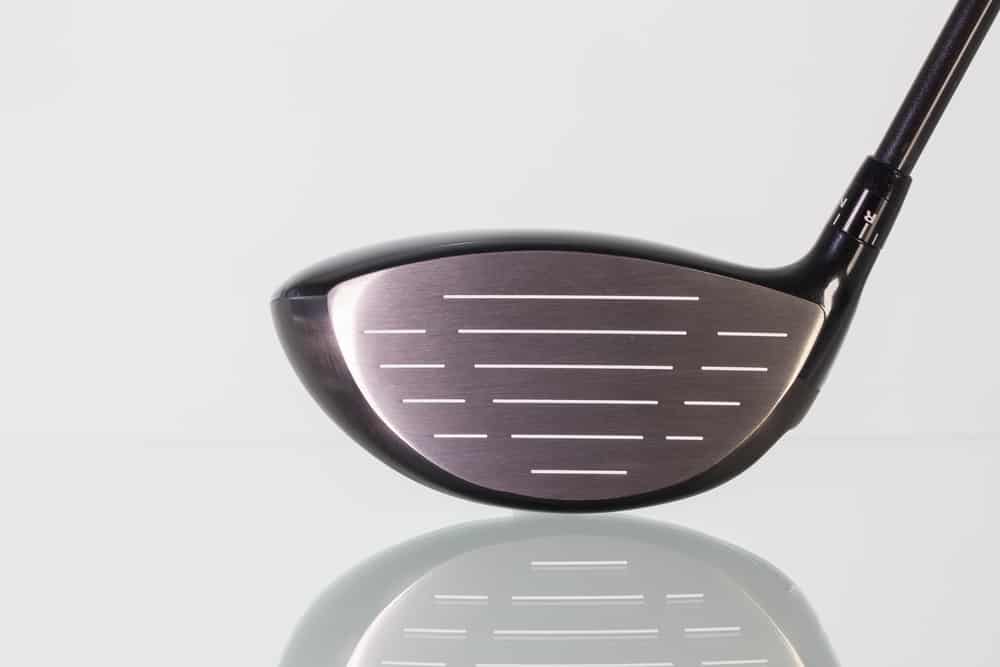
Now that you know the importance of the loft of the driver, you may be starting to wonder if adjustable drivers are a good idea.
Having the ability to change the loft on your driver whenever your game needs it is very important.
Adjustable drivers give people the opportunity to change the loft or lie depending on the course they are playing and what works for their needs.
Adjustable drivers usually can be changed by around 2 to 4 degrees in loft.
This is more than enough to accommodate a player and the lofts that they may need.
Adjustable golf drivers are often available for the same price as a traditional driver.
This leads many golfers to question why all golf drivers aren’t made with adjustable technology.
The reason behind this is mainly related to the weight and sometimes the pricing of the driver.
For the really inexpensive golf drivers, adding the adjustability is going to be quite expensive.
For other companies, like Cleveland Golf, for example, the adjustable golf drivers are too heavy.
All of those adjustable hosels make it difficult for the club to be as lightweight.
When you go back to the traditional hosel, it saves a lot of weight and can make it easier for golfers to get club head speed.
Overall, we believe that adjustable drivers are worth the money you pay for them.
What Loft Driver Does Dustin Johnson Use?
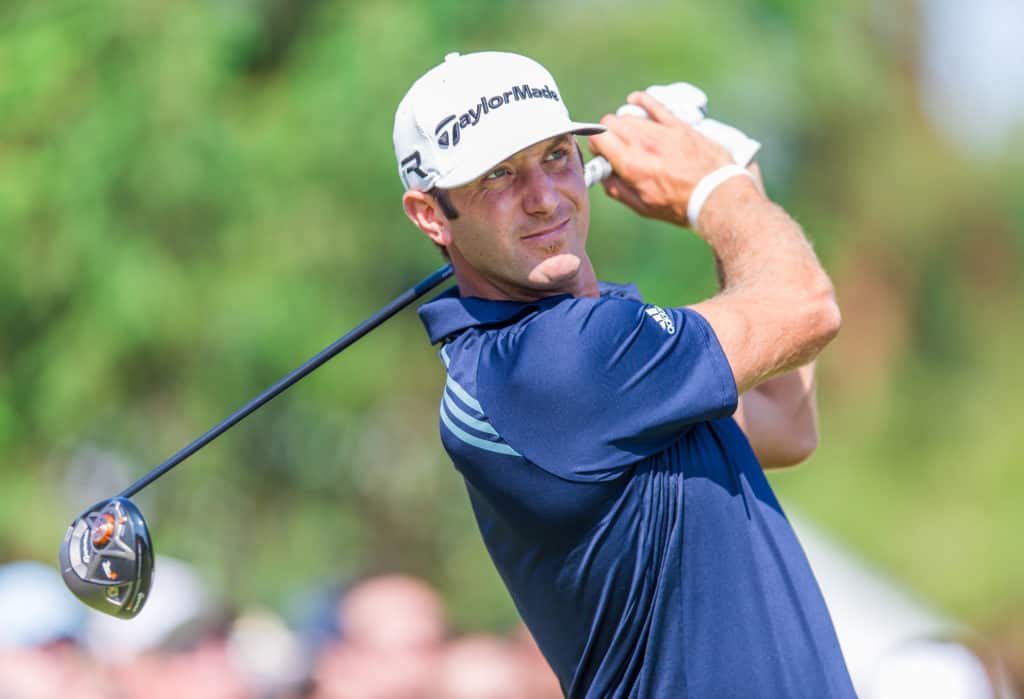
Dustin Johnson is a fun golfer to watch because he is so tall and has so much natural power that, when he makes contact with the ball, it seems to fly forever.
Johnson is one of the longer driving golfers on tour, and he is also a fan favorite.
We love to watch Dustin play and see all that he has accomplished with this game.
Many players want to be just like Dustin because of his ability to hit long and effortless drives.
With a player like Dustin, you would expect that the loft on his driver was closer to 9 degrees.
Having this much club head speed is undoubtedly a great feature and should be utilized.
Interestingly enough, Dustin Johnson is best known for playing a 10.5-degree driver.
The exciting thing about this is that many amateur golfers can play with the same loft that Dustin is using to win all of these events.
Certainly, going to a slightly higher lofted driver has not cost Johnson any yardage in his last few events.
What Loft Driver Does Tiger Woods Use?

Even though Tiger is not playing currently, the most recent driver that he had in his bag had 9 degrees of loft.
We all know Tiger as being one of the longest driving and most consistent golfers on tour.
There is no question that he generates enough clubhead speed to hit with almost any driver that he would like.
Nine degrees is hard for a slower swinging amateur golfer to be consistent with.
However, we all know that Tiger has speed that most of us will never see in our lifetimes.
Hopefully, when he comes back to golf, he will be able to use a driver like this again.
To ease back into the game, you may see Tiger using a driver with a little more loft and then eventually drop it back down to where it used to be.
Are Higher Lofted Drivers More Forgiving?
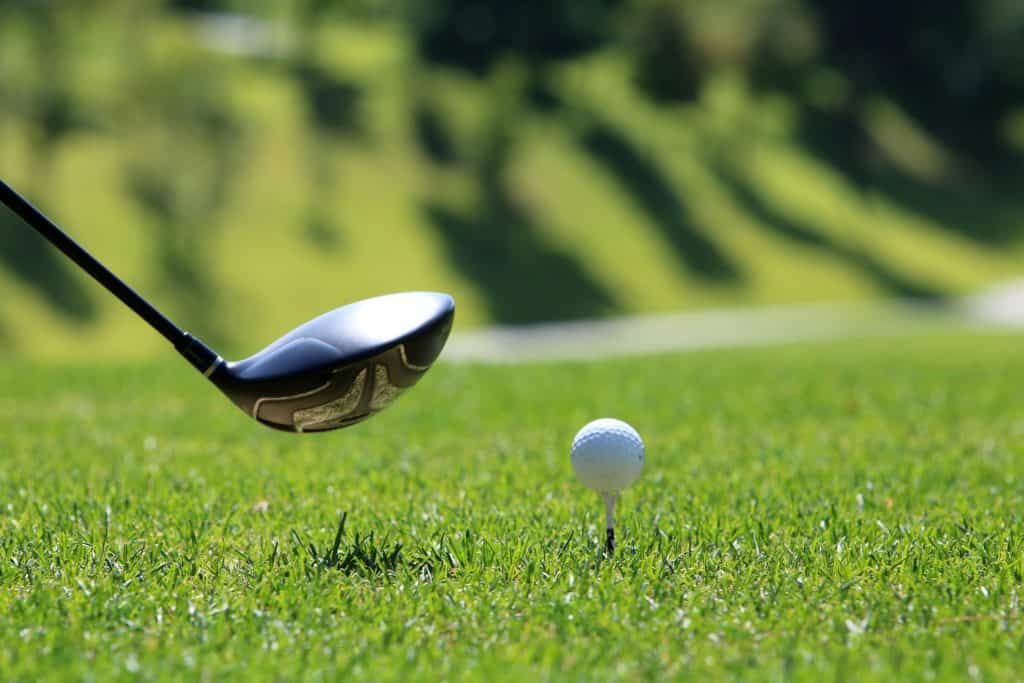
The higher lofted driver is more forgiving, and this is a major consideration that players need to make when they choose their clubs.
The higher lofted drivers give golfers with severe slices or hooks quite a bit more forgiveness on their shots.
With a higher lofted driver in your hand, you will likely have no trouble straightening out your shots.
However, you will reach that point in your game where the loft on the driver is actually a bit too much, and you need to get the ball flight evened out.
Finding that exact point is going to take a bit of time and experimentation.
When you find a driver with specifications that work well for your game, ensure that you remember those specs and continue to use them for years to come.
Sometimes the professionals give us a good indication of the best equipment on the market.
Other times, we should only use what they say as a guide and make decisions based on the needs of our own golf game.
When it comes to driver loft, we highly recommend choosing something that matches your game as opposed to matching the game of a professional.
Just because Bryson DeChambeau uses a certain club, it does not necessarily mean that this club would be the right choice for you.
Make some smart decisions when it comes to the loft of your driver, and you will likely have that club for years.
Related Posts

About Brittany Olizarowicz
Britt Olizarowicz started playing golf at the age of 7. She played Division 1 College golf at St.Johns University, where she won two tournaments at the collegiate level. After college Britt went on to become a Class A PGA Professional. Her love for the game spans almost her entire life. Today Britt loves sharing her knowledge of golf through her writing. After all, to teach the game of golf, you must first have a love for it.
Reader Interactions
Leave a reply cancel reply.
Your email address will not be published. Required fields are marked *
Important Info
Safety Disclaimer
Privacy Policy
Travelers Championship
TPC River Highlands
Dustin Johnson's driver is a reminder that optimal launch conditions boost yards
By E. Michael Johnson
At the WGC-HSBC Champions, Dustin Johnson took the title using a TaylorMade SLDR driver with 10.5 degrees loft. Although TaylorMade has recently been touting the benefits of "lofting up" with its new driver, it's actually been a trend on the PGA Tour for more than a decade.

Photo: Andrew Redington/Getty Images
Driver lofts have been on the rise since multilayer, solid-core balls burst onto the scene in large numbers in late 2000.
Early in the same year the average driver loft on tour was around 8 degrees. In 2002 it rose to approximately 8.5 degrees. By the 2008 Deutsche Bank Championship it was all the way up to 9.17 degrees, and then five years later, at this year's Deutsche Bank, it was 9.39 degrees. At the WGC-HSBC it was even higher: 9.41 degrees.
Related: Can Johnson be a great one?
Part of the reason for the increase is that lofts at the low end and on the high end have done a near complete flip-flop, witnessed by these numbers from 2002 and this year. In 2002 there were often as many as 30 drivers in play with lofts of 8 degrees or lower and only five (give or take, depending on the week) at 10 degrees or higher. This year most weeks saw around 10 drivers at those lower lofts and far more than 20 at the higher end. At the WGC-HSBC, for example, there were 23 drivers in play with lofts of 10.5 degrees or higher -- and that was in a field of just 78 players.
There is no single reason for the boost in driver lofts among pros. Rather, a number of equipment technologies have come together resulting in the need for additional loft. Drivers with center-of-gravity positions and other attributes designed to kill spin, solid-core balls that spin lower and the emergence of launch monitors all have contributed to players reaching for more loft.
Launch monitors revealed that high launch with low spin offered the greatest distance off the tee. When golf balls went from high-spinning liquid-center wound construction to lower-spinning solid-core multilayer models, the low spin part was a given, and it didn't take long to understand that more loft would create the high-launch part. However as more drivers were created to produce low spin, achieving the optimal trajectory and launch angle became more difficult. In 2008 the average launch angle on tour was 11.26 degrees. In 2013 it was 10.87 degrees.
That means that even though driver loft has gone up about .25 degrees over the past five years, launch angle has decreased approximately .4 degrees. It helps explain why a player with the strength and clubhead speed of Johnson still needs more loft to get the most out of his tee shots.
Related: The clubs Dustin Johnson used to win the WGC-HSBC
And what of everyday players? Although many amateurs remain reluctant to loft up, Tom Wishon, owner of Tom Wishon Golf, produced data a few years ago that revealed a golfer with a 12-degree launch angle swinging at 90 miles per hour with a modern driver under fairly normal conditions could gain an additional nine yards of carry by going from a 9-degree driver to a 13-degree driver. Yet the most popular driver lofts at retail continue to be 9, 9.5 and 10 degrees.
To those still playing with too little loft: If Johnson, the game's ultimate Mr. Macho, just went to 10.5 degrees, then what are you waiting for?
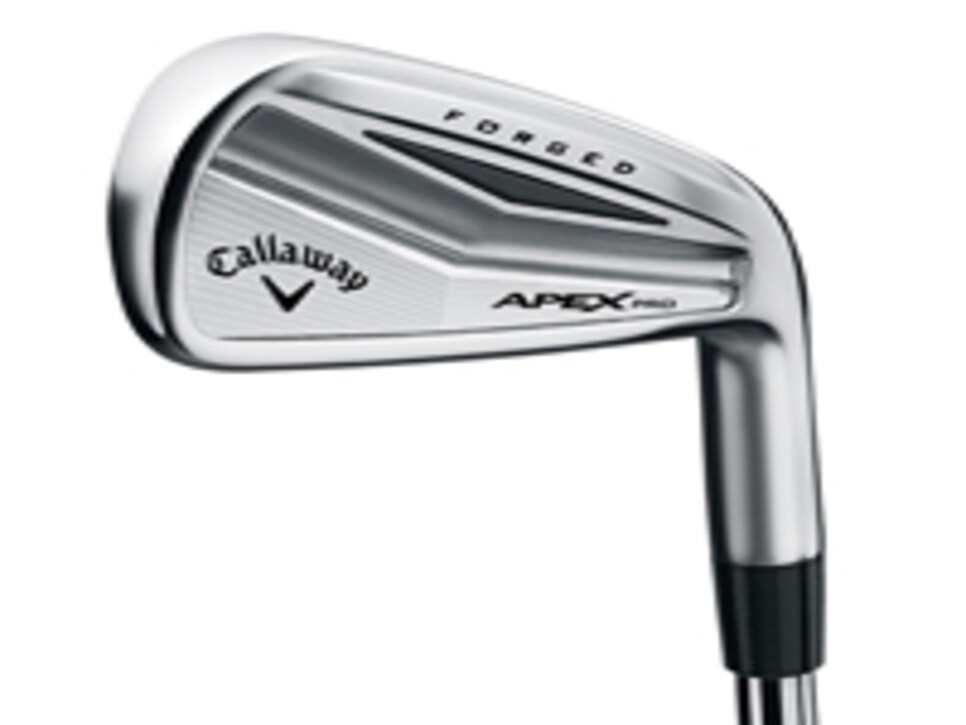
PRICE: $1,100 (set of eight, steel)
The Apex Pro uses a progressive center of gravity through the set to provide more carry on the long irons and a flatter trajectory for control on the short irons.
CallawayGolf.com
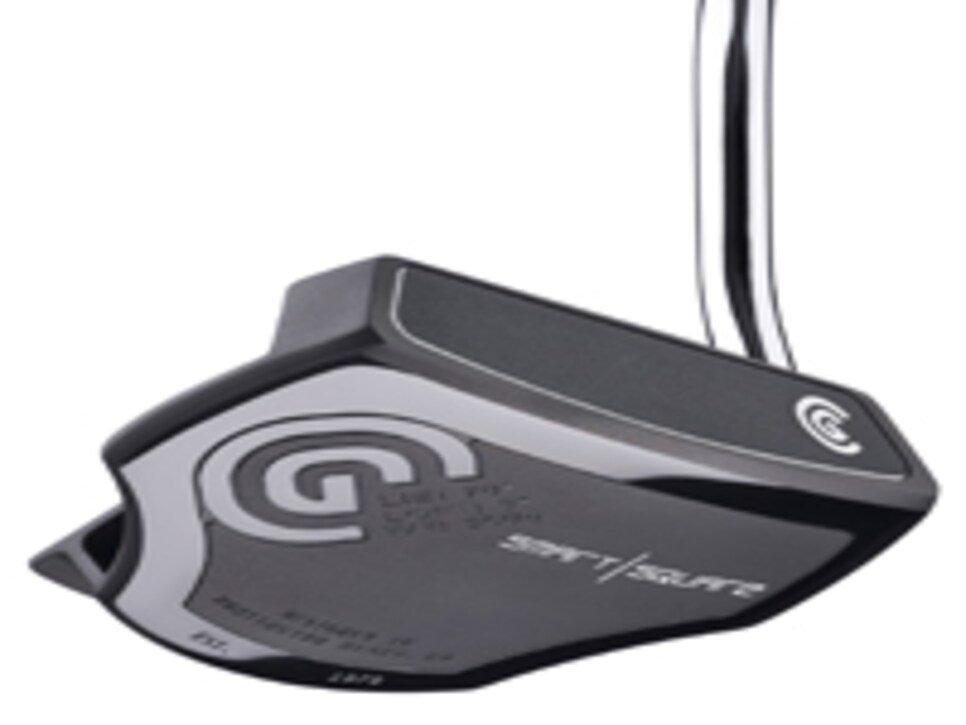
PRICE: $140/$180 (Heel-, center-shaft and counterbalanced)
The Smart Square mallet is designed so the parallel and perpendicular lines better frame the proper path for your putt.
ClevelandGolf.com
Kenny Perry had a new club in his bag as he sewed up the season-long Schwab Cup points title at TPC Harding Park -- a Hopkins Golf 60-degree wedge. Perry's use of the club capped a solid first year on the Champions Tour for the fledgling company as 32 players used Hopkins Golf wedges in competition. ... After testing both Titleist's Pro V1x and TaylorMade's Lethal ball in recent weeks, Ernie Els was back with Callaway's HEX Black model at the WGC-HSBC Champions in Shanghai where Els finished T-11. ... Billy Horschel has agreed to a new multiyear deal with Ping. Horschel, who was 16th in the 2013 FedEx Cup standings, used the company's G25 woods and new S55 irons at the WGC-HSBC event as well as a custom-made Redwood Piper putter. ... Golf Pride will be showing its new Tour Velvet Super Tack grip to players at the McGladrey Classic. The grip -- the first new grip under the Tour Velvet name since 2009 -- will be available at retail in spring 2014. ... Tim Burke of Orlando won the Re/Max World Long Drive Championship in Las Vegas with a blast of 427 yards using a Krank Golf Formula 5 driver (Fujikura Flywire XXX LD shaft) with 3 degrees loft and a Top-Flite XL ball for the winning swat.
Follow @EMichaelGW
More from Golf Digest
Trending now.
3 Million Annual Readers >
2,300+ Products Tested >
300+ Reviews Completed >
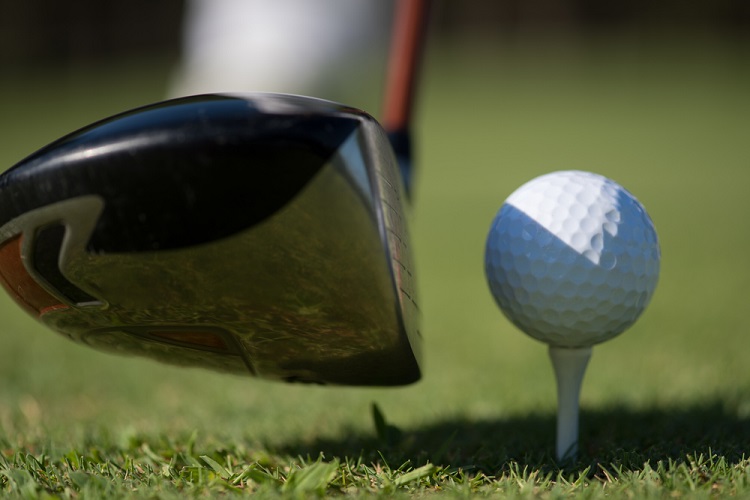
Best Driver Loft for Distance: What Driver Loft Should I Use
Every golfer wants more distance from their driver, but do they know how to make that dream a reality?
While there are several components worth noting, one of the biggest features of the driver that most amateurs overlook is the loft.
The loft angle of the face of the driver is responsible for higher launch, low spin, and optimal trajectory to get the most from your drives.
Some golfers have too much driver loft, while others don’t have enough, so most players ask is: What’s the right amount of loft on your driver?
We’re here to answer all of your questions!
Table of Contents
What is the Best Driver Loft for Distance?
Why is driver loft important, which driver should i use, callaway paradym ai smoke max driver, taylormade qi10 driver, ping g430 max 10k hl driver, cobra darkspeed x driver, who needs low loft drivers, who needs high loft drivers, is there a big difference between 9 and 10.5-degree driver, what loft should i use for my driver, will a higher loft driver help my slice.
The best driver loft typically measures around 10.5 degrees.
While more advanced golfers will benefit from using lower lofted drivers and high handicappers will need more loft to produce the carry they are missing, the best driver loft to use for inexperienced golfers is around 10.5 degrees.
Driver loft is so crucial because it determines the launch of your drive. If you hit the golf ball too high, the ball takes a tall arc, sacrificing distance for height.
The opposite is true, as too little driver loft can turn the tee shot into a line drive with far less loft than necessary for maximum distance.
With a solid angle of attack, optimal driver loft on your driver will maximize golf ball distance and roll, regardless of your swing speeds.
Too much driver loft can kill the potential to reach the distances necessary to shorten second shots.
While there are several essential factors for hitting the longest drives of your golf career, finding the best driver for reaching long distances starts with finding the one with the right driver loft.
Best Low Loft Drivers
Best Low Loft Driver

Specifications
- Loft: 9°, 10.5°, 12°
- Shaft Length: 45.75”
- Swing Weight: D2
- Adjustable weighting and loft sleeve
- Very forgiving sweet spot
- Fast ball speed with low spin
- Wilder appearance, not for everyone
- Very firm with a stiffer response
Offering a capable assortment of adjustable features, the Ai Smoke Max Driver delivers premium performance for a low-lofted driver.
The very forgiving Ai-designed face helps increase ball speed on off-center strikes for straight, fast drives.
Our favorite feature of the Ai Smoke Max is the sliding rear weight that adjusts ball flight, which is great for golfers struggling with slices or hooks.
The weight can also be partially adjusted for a more subtle correction that helps when looking to create baby draws and fades.
Even though it comes at an elevated price, the Ai Smoke Max is a superb option for golfers who want the low, penetrating flight provided by a low-lofted driver.
Read our full Callaway Paradym Ai Smoke Drivers Review
Best Low Loft Driver for Distance

- Loft: 9°, 10.5° & 12°
- Lie: 56°-60°
- Swing Weight: D4
- Lacks adjustable sliding weight
- Doesn’t have the curb appeal of the Stealth series
Although the regular Qi10 Driver from TaylorMade doesn’t have adjustable weighting, its 9-degree option does wonders for golfers needing more distance off the tee box.
Our favorite feature of the Qi10 is the stable, consistent ball flight. The ball jumps off the face with incredibly high speed and minimal spin.
The Twist Face technology also helps reduce side spin to keep your ball in the fairway.
On off-center strikes, the lower loft helps keep the drive low to the ground with maximum speed. Dispersion remains remarkably tight for all golfers with the Qi10.
Check our honest TaylorMade Qi10 Driver Review
Best High Loft Drivers
Best High Loft Driver
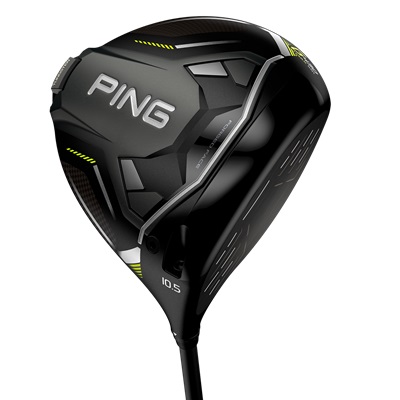
Check Price on PGA Tour Superstore Check Price on Global Golf
- Swing Weight: D3
- Lightweight but very powerful
- Incredibly stable through impact
- Minimal spin for straight drives
- Feels thin on off-center strikes
- Unique Ping design isn’t for everyone
For golfers who want maximum MOI with high launch and extended carry, the higher lofted options with the Ping G430 Max 10K driver offer exceptional ball speed and distance to burn.
The lightweight design keeps swing speed off the charts, which is excellent for golfers struggling with length off the tee box.
The G430 Max 10K’s unique design is built for speed. The ribbed crown slices through the air to deliver maximum power to the golf ball.
We absolutely loved the sound at impact because it’s not too thin or heavy, just 100 percent pure.
Check our honest Ping G430 Max 10K Driver Review
Best High Loft Driver for Distance

- Lie: 56.2°-57.2°
- Shaft Length: 45.5”
- Swing Weight: D1-D4
- Booming distance with high launch
- Great for golfers wanting to improve distance
- Sturdy and consistent ball flight
- No adjustable weighting
- Lacks contrast on the crown for alignment
Cobra’s lightning-fast Darkspeed X Driver delivers high launch with a soaring ball flight that produces extended carry and shortens the length of your approach shots into the green.
With stabilizing weights along the sole, the Darkspeed X produces high MOI through the impact zone.
We loved how repeatable shots off the X were on the range and course. The higher loft works well with the aerodynamic design to improve overall distance with maximum swing speed.
Great for high and mid handicappers, the Darkspeed X offers a nice blend of forgiveness, low spin, and trajectory control.
Here’s our full Cobra Darkspeed Drivers Review
Fast Swing Speed
For golfers with dramatically high swing speeds, a lower lofted driver can power the ball further than ever before.
Increasing carry distance is vital to increasing length, and a driver with 8.5-9.5 degrees is the loft to get to boost yardage.
By lowering the launch of the drives, the high swing speed helps muscle the ball down the fairway.
When the lower loft is paired with less spin, the new driver can increase golf ball speed without worrying that the golf ball is headed into the rough.
Experienced Golfers
Long time golfers can also benefit from adding a lower lofted driver to their game, as long as they maintain a positive attack angle to the ball and hold moderate club speed.
A flatter plane provides numerous benefits for these golfers, including offering a measure of distance with accuracy.
While experienced golfers might have clubhead speed that dips below 100 mph, they can still reach extended distances on the course with the right golf equipment.
Adding a distance ball and a lower loft of the driver will fine-tune the trajectory of the drive without losing precious yardage.
A higher loft degree driver can send shots far too high, suffocating the distance that most golfers at this skill level need to post low scores.
One-Plane Players
With Bryson DeChambeau taking over the PGA Tour with his enormous muscles and equally huge driving distance, the push to find a lower lofted driver has become popular among amateurs.
DeChambeau plays with a 5.5-degree driver on tour, but his incredible swing speed gives him the advantage of playing a driver with that reduced launch.
DeChambeau uses his one-plane swinging path to create a positive attack angle on the ball, despite the severe loft on the club.
Since most amateurs play with a two-plane approach, the lower lofts available on most drivers can help a golfer switch from two to one-plane.
A beginning golfer will typically display a slower swinging speed of around 80 mph. The ball will not travel as far since the clubhead speed is slower than most golfers.
A golfer needs a higher loft on their driver’s clubhead to increase distance.
Finding a driver that has a 12-degree loft or higher is a great place to begin to add more carry to your drives.
High Handicappers
For golfers that find their handicap hovering around 18 or more, a driving wood with a lower center of gravity can help improve the attack angle of the club and allow the player to hit the ball with lesser spin loft and more carry.
Since these golfers have experience playing the game, just a few equipment tweaks can help maximize their distance and open a new measure of success to their overall skill level.
Senior Golfers
Since senior golfers need to maintain their club speed and increase their launch to successfully hit long drives, a high loft driver can increase the launch angle off the clubface.
A senior player can maximize their impact on the golf ball with enhanced trajectory, resulting in increased yardage.
Another aspect of a high loft driver for senior golfers that can help increase success is finding the right shaft flex for the club to match clubhead speed.
Women Golfers
An increase in loft angle for women golfers can benefit their game by adding more carry and forward roll after the ball hits the fairway.
On the tee box, the right driver can revolutionize the game of a female golfer, so finding higher lofts and the correct shaft for their driver can offer the right combination to hit the best drives of their golfing journey.
The best loft for women golfers with an average ball speed is around 10.5-13 degrees. This clubface loft will reduce spin, increase launch angle, and improve attack angle for increased yards from the tee.
Frequently Asked Questions

Yes, there’s quite a bit of difference in that 1.5 degrees.
A 10.5-degree driver will provide more launch, better for mid and high handicappers, while a 9-degree driver works better for golfers with a high swing speed because it produces a lower, more penetrating flight similar to what we see with the pros.
If you are a high handicapper or beginner, you should start with 12 degrees of loft on your driver.
For advanced players, 9 degrees and lower should offer the lower launch with minimal spin that low handicappers need to attack the fairway.
Mid handicappers will find 10.5 degrees works best off the tee box.
A high loft driver will help extend distance off the tee box by providing a higher launch, but it won’t help your slice. Instead, you should look for a driver with draw bias to help minimize side spin.
If you want a more sophisticated and subtle approach to fixing your slice, find a driver, like the new Paradym Ai Smoke Max, with a sliding weight that provides muted slice correction.

- X (Twitter)
What Driver Loft Should You Use? Everything You Need to Know

A 10.5° golf driver loft is optimal for novices and many players. If you’re new or possess a slower swing, opt for a higher loft driver for better compatibility. Greater loft enhances forgiveness due to its facilitation of an upward attack angle.
Reduced loft facilitates increased distance with decreased spin. Generally, higher swing speeds necessitate less lofted drivers.
I often observe golfers employing improper driver lofts, detrimentally affecting their drives. Driver lofts typically span from 8° to 14°.
To aid visualization, I’ve included a driver loft chart. Thoroughly digesting this article will illuminate the appropriate driver loft as your game progresses.

Note: While you can estimate a suitable driver loft based on your swing speed, individual needs may vary. Hence, I advocate for club fitting. Explore Brendon’s comprehensive club fitting journey at the PGA Tour Superstore.
Which Driver Loft Is Optimal for High Handicappers?
A 10.5-degree loft driver is ideal for high handicappers and novices. This explains why beginner-friendly drivers often feature loft angles of 10.5° or higher.
A higher loft enhances forgiveness and elevates ball trajectory but sacrifices some distance due to increased spin. Given high handicappers’ emphasis on hitting fairways rather than maximizing distance, a 10.5 driver is preferable.
Higher lofted clubs are more forgiving. Hence, hitting a 9-iron is easier than a 4-iron, albeit with lesser distance. I refrain from delving into individual club lofts, focusing solely on driver loft in this article.
If you struggle with drives and suspect your driver loft, aligning it with your swing can enhance performance without necessarily requiring a new shaft.
For high handicappers, I recommend transitioning to a loftier driver.
Options abound if your driver loft proves excessively high for your swing:
- Utilize a driver with an adjustable hosel to moderately decrease loft.
- Consider customization, albeit a costly route.
- Ponder a strong lofted 3-wood with 13 to 13.5 degrees of loft.
While most opt for a 9° or 10.5° driver, experimenting with a 12-degree variant is plausible.

Which Driver Loft Suits Low Handicappers?
Professional golfers and low handicappers typically favor a 9-degree driver loft.
As your golfing prowess evolves, reconsidering your driver loft becomes imperative. Low handicappers aim to maximize driving distance while minimizing spin.
For these players, a 9-degree driver offers low spin, controlled ball flight, and optimal roll.
Conversely, utilizing a high lofted driver with a swift swing speed (exceeding 100 mph) may result in an open-face contact, inducing a slice.
Having faced similar challenges, transitioning from a 10.5 to a 9.5 driver, coupled with extensive driving range sessions, yielded tangible improvements.
It’s crucial to acknowledge that a lower loft driver isn’t universally superior for rapid swing speeds, and there’s no definitive optimal driver loft for distance. While golfers like Bryson DeChambeau opt for a 5-degree lofted driver, many PGA tour players employ a 10.5-degree variant.
I’ve compiled a table showcasing professional golfers’ statistics, underscoring loft’s role in maximizing distance.

Low Lofted vs. High Lofted Drivers
Drivers with 9.5° or lower loft are classified as low lofted, whereas those exceeding 10° belong to the high-lofted category.
High lofted drivers benefit most amateurs by enhancing launch, accuracy, and spin off the tee.
Insufficient loft relative to clubhead speed leads to inadequate carry, distance, and erratic dispersion.
Opting for a lower lofted driver may result in sliced shots, veering towards the right rough. Conversely, higher lofted drivers tend to impart a draw bias, promoting snap hooks.
However, higher lofts coupled with rapid swing speeds generate increased spin, elevating ball flight and yielding a steep descent, thereby impeding roll and total yardage potential.
Who Benefits from a High Lofted Driver?
High-lofted drivers are primarily suited for:
- Novice golfers
- High handicappers
- Golfers with sluggish swing speeds
- Those struggling to launch the ball upward
- Senior golfers
Who Should Utilize a Low Lofted Driver?
Low lofted drivers are typically favored by:
- Golfers boasting swift swing speeds
- Low handicappers seeking greater carry distance
- Individuals grappling with excessive spin
- Golfers experiencing a higher launch angle than desired
Is a Higher Loft Driver Superior?
In my experience, a higher lofted driver proves advantageous for most amateur golfers, facilitating consistent tee shots. However, rapid swingers may generate excessive spin and a ballooned shot, diminishing total distance.
What Loft Should I Opt For With My Driver?
Golfers boasting rapid swing speeds are advised to wield a 9-degree driver or lower. Conversely, moderate swingers should opt for a 10.5-degree driver, while those with sluggish swings are better served with a 12-degree or weaker driver.
Does Reducing Driver Loft Open the Face?
Yes, reducing driver loft indeed opens the clubface angle, as evidenced by Mobile Clubmaker Golf’s demonstration in this YouTube video. Strengthening the loft opens the clubface, whereas weakening it closes the angle, fostering a draw bias setup.

Steve Morgan, is a passionate golfer and the creator of ThrillGolf. Although he isn't nearly a pro, he has more than 10+ years of international coaching and playing experience. His goal is to improve the golfing community's experience in selecting appropriate equipment and determining the best setup for their swing.
Related Posts

Scottie Scheffler WITB ( What’s In The Bag )

Lydia Ko WITB (What’s In The Bag)

Ludvig Aberg WITB: Inside the Bag of a Rising Golf Star
Please verify you are a human
Access to this page has been denied because we believe you are using automation tools to browse the website.
This may happen as a result of the following:
- Javascript is disabled or blocked by an extension (ad blockers for example)
- Your browser does not support cookies
Please make sure that Javascript and cookies are enabled on your browser and that you are not blocking them from loading.
Reference ID: e690efbd-329f-11ef-ad59-6f7821240334
Powered by PerimeterX , Inc.

Cameron Young's Aides For Shooting Lowest Round in PGA Tour History, 59: WITB For 2024 Travelers Championship Explored
What drivers, fairways, and irons do cameron young like to use, wedges, putter, and more.


Jun 20, 2024 | 11:16 AM EDT

USA Today via Reuters
Mar 4, 2021; Orlando, Florida, USA; Rickie Fowler hits his drive on the 18th hole during the first round of the Arnold Palmer Invitational golf tournament at Bay Hill Club & Lodge. Mandatory Credit: Reinhold Matay-USA TODAY Sports | REUTERS
The best memory golf enthusiasts still hold off Rickie Fowler was his 2012 Wells Fargo Championship win. Where he catapulted as a rising star, after beating Rory McIlroy for the final hole playoff. The American has secured just five PGA Tour wins since that iconic moment. This year adds up to yet another winless season for Fowler so far.
Despite participating in 16 events, he has failed to secure a top-10 position, with only one top-20 finish at the RBC Heritage tournament. The last time he tasted victory was at the 2023 Rocket Mortgage Classic. Now after missing the cut at the 2024 U.S. Open, how will things turn for the 35-year-old when he returns to the greens at TPC River Highlands, and what is he carrying in his bag to end his drought?
Rickie Fowler’s bag is almost full of Cobra clubs
ADVERTISEMENT
Article continues below this ad
Current OWGR rank 49 uses a Cobra DARKSPEED X driver with a 9-degree loft. The Driver blends extraordinary speed and forgiveness for him seeking maximum distance with higher launch and added stability. He first played with the driver at the Netflix Cup in November 2023. It is priced at $599. The shaft fitted to it is a Project X Denali Black 70TX. It offers outstanding strength and increased energy transfer to the golfer. The toughness of the shaft allows for superior strength and stability, helping the golfer showcase better skills.
For his 3-wood the 35-year-old uses Cobra Aerojet LS fairway wood with a 14.5-degree loft. It is the lowest spinning fairway model from Cobra and provides more distance for players like Rickie. The adjustable forward weights aid in maximizing speed and spin reduction. The price comes in the range of $249. The pro golfer uses Cobra LTD x LS as his 5-Wood with a 17.5-degree loft. His 5-wood retails around $199. The golfer uses an Aldila Tour Green 75 TX shaft for his 3-wood and a UST Mamiya LINQ M40X 8F5 shaft. 5-wood.

Mar 20, 2021; Palm Beach Gardens, Florida, USA; Rickie Fowler looks at his club after chipping on to the 18th green during the third round of The Honda Classic golf tournament. Mandatory Credit: Jasen Vinlove-USA TODAY Sports
Moving on to the irons, the 6 time PGA Tour winner’s iron choice starts from four, he relies on Cobra King Tour (4-PW) irons. The irons are fitted with KBS Tour C-Taper 125 S+ shafts. The Tour irons’ updated shape features a slightly shorter blade length than the previous KING Tour MIM Irons, which in turn provides improved control and workability for the golfer. The market value of the set is around $1,299. This is not all that he holds in his bag.
What wedges and putter does the American use?
Rickie Fowler uses a Cobra King Snakebit Wedge, with a 54, 56, and 58-degree loft, priced at $149. He pairs his wedges with KBS Tour 610 shafts. It features the most aggressive grooves to date designed by Cobra to maximize the spin for the professional. Moreover, its versatile notch design delivers a flexible shot-making around the greens.
It comes in three grind options, VERSATILE, CLASSIC, and WIDELOW. The “versatile” grind features toe, heel, and trailing edge relief, the “classic” grind features a progressive sole width from heel to toe, and the “widelow” grind features a wide sole with a reduced bounce.
Rickie Fowler’s bag includes just one standout brand, the Odyssey Versa Jailbird with a SuperStroke Tour 3.0 grip. The trusty tool that broke his four-year winless streak in 2023. This putter has already delivered magic once, and Fowler is undoubtedly hoping it will cast its spell again at the Travelers Championship. Additionally, he uses the TaylorMade TP5x ball with a triangle Pix design on it, which adds clear path alignment to help him roll in the putts.
Are you excited to see what happens at the 2024 Travelers Championship venue and who amongst the gentlemen lift the Travelers trophy? Can Rickie Fowler end his drought with the help of his gear? Stay tuned to find out!

EssentiallySports is a digital-first sports media house that surfaces the best stories on America's favorite sports celebrities with a fan's perspective to 30+ M average monthly readers.
Formula One
ONE Championship
Bodybuilding
EssentiallySports
Advertise With Us
Editorial Team
Behind The Scenes
Humans of EssentiallySports
On The Ropes
Bodybuilding Bros
Lucky Dog on Track
Privacy Policy
ES Pressroom
Ethics Policy
Fact-Checking Policy
Corrections Policy
Cookies Policy
GDPR Compliance
Terms of Use
Editorial Guidelines
Ownership and funding Information
Full Spectrum Services LLP © 2024 | All Rights Reserved
Please enable JS and disable any ad blocker

Travelers Championship
TPC River Highlands
Cromwell, Connecticut • USA
Jun 20 - 23, 2024
Scottie Scheffler Captures Fifth Win of 2024 with Qi10 Driver and Spider Tour X at The Memorial

SCOTTIE SCHEFFLER WITB
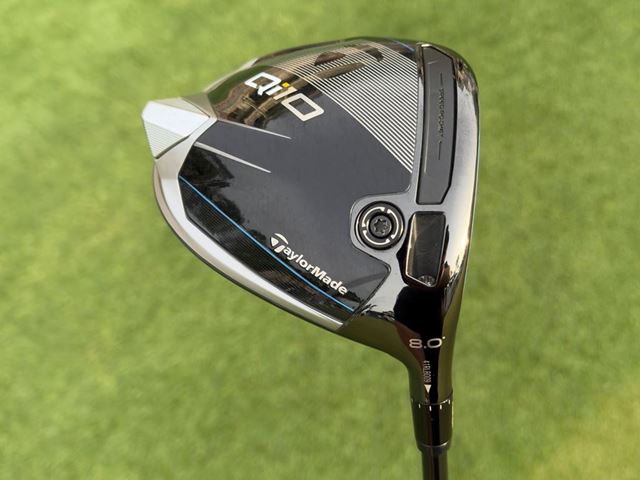
SCHEFFLER’S Qi10 DRIVER SPEC
Quotable from scheffler’s qi10 driver fitting , how scheffler benefits from true path alignment .
SCHEFFLER’S SPIDER TOUR X SPEC
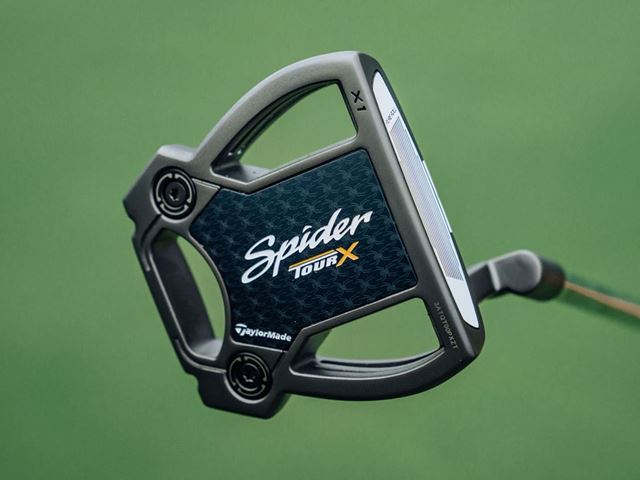
WHY SCHEFFLER PLAYS P·7TW IRONS
Blueprint T
Blueprint t image viewer, blueprint t: selected image.

You May Also Like
PING Blueprint T Technology

Tour Collaboration
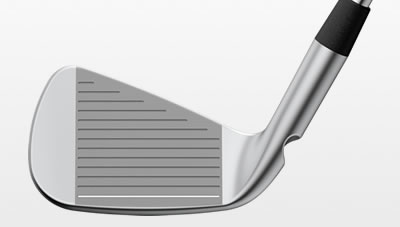
Machined Face & Grooves
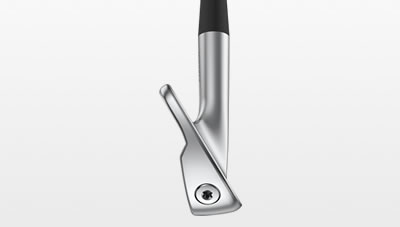
Narrower Sole
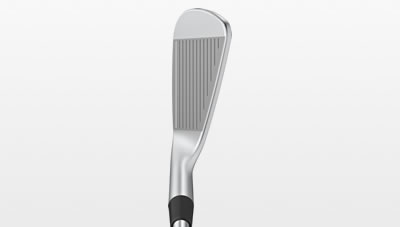
Clean, Compact

Winning Design
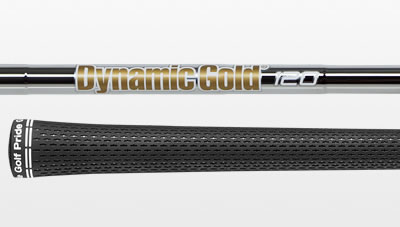
Shaft, Grip
Blueprint t reviews, blueprint t specifications.
- These are design specifications that may vary due to manufacturing tolerances.
- Lie angle is based on Black Color Code at standard length.
- Power Spec Loft is a fitting option for players looking to boost their iron distance or decrease spin to hit a desired trajectory window. This custom-designed loft configuration delivers a calculated power boost without sacrificing the integrity of the club’s design.
- Retro Spec Loft is a fitting option if you’re less concerned with overall distance and more with precision and a higher trajectory for more stopping power. This loft configuration yields functional distance gaps for utilizing a 3-wedge setup or a more classic loft spec.
- Club bounce angles will vary slightly if ordered with non-standard loft specs.
- Achievable swingweights depend on shaft, length and grip combinations.
- Available in left- and right-handed models.
Blueprint T Shafts
PING offers a variety of shaft flexes in steel and graphite to meet your needs and preferences. Selecting the proper shaft flex for your swing will help you get the most distance and accuracy from every shot. Generally, players with faster swing speeds require stiffer shafts to keep the ball trajectory lower, while players with slower swing speeds will require more-flexible shafts to produce a higher ball trajectory.
The choice of steel or graphite shafts is usually based on preferences for weight and/or feel. Players seeking a lighter overall weight and/or a softer feel in their irons may prefer graphite shafts, while players who prefer a standard-weight club with a firmer feel may prefer steel shafts.
We recommend that you get fit for the shaft that allows you to play your best golf. Whether that’s a softer, lighter shaft with a higher launch or a heavier, stiffer shaft with a lower trajectory, a PING Certified Club Fitter can help you find the shaft that brings consistency to your game.
- Shaft weights listed are based on the trimmed length of a 7-iron and may not match the specs on the shaft manufacturer’s websites.
- Graphite shafts are not available for the Blueprint T.
Blueprint T Grips
PING offers a variety of grip sizes and styles to fit different hand sizes and texture preferences. Since grip size influences your wrist action, and therefore the direction of your shots, it is commonly used by fitters to affect ball flight.
PING color-coded grips are available in six different diameters, and can be further customized with grip tape according to your needs. Once the neutral grip color code has been determined based on hand measurements, golfers may consider smaller diameter grips to help control fades and slices, or larger diameter grips to help control draws and hooks.
Arccos Smart Sensors “Customer Appreciation Program.” How It Works:
- Own or purchase any driver, fairway wood, hybrid, crossover, iron, wedge or putter.
- Visit subscribe.arccosgolf.com/ping to request 14-piece Smart Sensor kit (13 swing sensors, 1 putter sensor).
- Sign up for 45-day free trial of Arccos app.
You Might Also Like
Find a ping fitter near you.

COMMENTS
10.5 Degree Loft. A 10.5 degree driver loft is suited to the recreational golfer who has a slower swing speed or doesn't hit the ball on an upward launch angle. Most golfers tend to hit downwards on the ball and a 10.5 degree driver will help you get the ball into the air even without the fastest of swings.
On the PGA Tour, it's relatively downward at -1.3. This is why some LPGA players could benefit from the lower-lofted drivers used by PGA Tour players swinging 20 or even 30 mph faster.
9 degrees is the most used driver loft among the top 100 PGA Tour pros with 32 setting up with it, including Rory McIlroy. 14 of this group play a 9.5º loft. The next most played degree of driver is 10.5º chosen by 8 pros with 8º and 10º used by 7 each. 6.5º is the lowest driver loft in the top 100 and 12.1º is the highest.
2016 - J.B. Holmes (314.5 yards) Driver: TaylorMade 2016 M1 430. Loft: 10.5 degrees (9.5 degrees actual loft) Shaft: Fujikura Pro Tour Spec 83X Prototype. Length: 45 inches. Swing weight: D4 ...
Driver lofts for most golf clubs range from roughly 8-11 degrees. For example, the popular Callaway Rogue ST Max driver has three options; 9, 10.5 degree, and 12 degree actual loft. While the TaylorMade Stealth is available in the same three options. Like other golf equipment, these are adjustable drivers on the market.
It's important to remember that a lower loft driver won't always be better for fast swing speeds, and there's no one best driver loft for distance. While golfers like Bryson DeChambeau stand out for having a 5-degree lofted driver , many PGA tour players also play with a 10.5-degree driver.
Golfers with this swing speed would typically benefit from a driver between 12-14° of loft. 2.Upward Hitters. Golfers that hit up on the ball (have a positive attack angle) will tend to spin the ball less because their spin loft is lower. So they can therefore afford to have slightly more loft to maximise distance.
Dynamic Loft - The vertical club face orientation at the center-point of contact between the club face and golf ball at the time of maximum compression [separator] [one_half] Tour Averages. PGA TOUR. Driver - 12.8 degrees; 6 iron -20.2 degrees; LPGA Tour. Driver - 15.5 degrees; 6 iron - 23.6 degrees
If you fall in the 70 mph or under range, it's best to select a driver with a loft of around 18-19 degrees (similar to a 5-wood). Most average handicap golfers will have a swing speed of around 80-90 mph and would benefit from a driver loft of anywhere from 10-12 degrees. If yourswing speed is 100 mph or more you can often step up to a driver ...
Schedule PGA Tour 2023-2024. Videos & Podcasts. ... Match your driver loft to your swing speed. By Michael Chwasky. August 7, 2019. Driver lofts have increased significantly in recent years.
What Driver Lofts Do The Pros Use. Most professionals on the PGA golf tour are using a driver with a loft between 9 and 10.5. The golfers will change the loft based on the shaft they have on their club and how the shaft impacts the ball flight as well. Most golfers on the professional circuit have a very fast swing speed.
To help fit his golf swing, Rahm prefers to have a bit more loft on his clubs. For example, his 10.5-degree Callaway Rogue ST Triple Diamond LS driver head has 11.2 degrees of actual measured loft ...
On the flip side, drivers found on the PGA Tour are digitally lofted to ensure the number is precise. With the amount of time pros spend dialing in their swing and launch characteristics on a ...
The loft is the angle of the clubface of a driver. Most drivers have a loft between 8 and 13 degrees. The 8 degree driver will have a much lower launch than the 13 degrees, and it will also impact overall distance and forgiveness. Many players think that the loft on the driver will impact only the launch angle of your golf shot, but there is ...
McIlroy had TaylorMade's new Stealth 2 Plus 3-wood and 5-wood in the bag when he played his first PGA TOUR event of 2023 at the WM Phoenix Open. He was still using last year's edition of the ...
Professional golfers tend to play with a driver that has about 9.5 degrees of loft. Of course, there are some golfers who find 10.5 or 8.5 to be more effective, but you will generally see most players end up in the 9 to 9.5 range. The loft on the driver makes it easier to launch. However, most players who are on professional golf tours do not ...
By E. Michael Johnson At the WGC-HSBC Champions, Dustin Johnson took the title using a TaylorMade SLDR driver with 10.5 degrees loft. Although TaylorMade has recently been touting the benefits of ...
With Bryson DeChambeau taking over the PGA Tour with his enormous muscles and equally huge driving distance, the push to find a lower lofted driver has become popular among amateurs. DeChambeau plays with a 5.5-degree driver on tour, but his incredible swing speed gives him the advantage of playing a driver with that reduced launch.
While tour players and elite amateurs often use drivers with single-digit lofts, most recreational players are best fitted between 10.5 and 12 degrees. The higher your swing speed and spin rate ...
Note: While you can estimate a suitable driver loft based on your swing speed, individual needs may vary. Hence, I advocate for club fitting. Explore Brendon's comprehensive club fitting journey at the PGA Tour Superstore. Which Driver Loft Is Optimal for High Handicappers? A 10.5-degree loft driver is ideal for high handicappers and novices ...
Find the golf driver that complements your playing style at PGA TOUR Superstore today! ... High Launch Refine by Loft: High Launch 11º Refine by Loft: 11º 39° Refine by Loft: 39° 63° Refine by Loft: 63° Clear; ... PGA TOUR Superstore has a wide selection of golf drivers for sale, with several brands such as Callaway, Cobra, PING, and ...
Jake Knapp's 13.5-degree TaylorMade BRNR Mini driver. (Credit GolfWRX) During a fitting session in Oklahoma last year, Knapp told his fitter he was looking for a club that goes 286 yards, and his ...
What drivers, fairways, and irons do Cameron Young like to use? At the heart of Young's equipment is the Titleist TSR3 driver, featuring a 9-degree loft and paired with an Accra Tour Z5 65 M5 shaft.
The American has secured just five PGA Tour wins since that iconic moment. This year adds up to yet another winless season for Fowler so far. ... Current OWGR rank 49 uses a Cobra DARKSPEED X driver with a 9-degree loft. The Driver blends extraordinary speed and forgiveness for him seeking maximum distance with higher launch and added stability ...
Scottie Scheffler captured his sixth victory of the season in a thrilling playoff (65-64-64-65) at the Travelers Championship with Qi10 driver and Spider Tour X putter. The victory marks his 6th in 2024, all coming with Qi10 8.0° driver, Spider Tour X putter, Qi10 3-wood and P·7TW irons in the bag.
PGA TOUR Live Leaderboard 2024 Travelers Championship, Cromwell - Golf Scores and Results
Prior to joining the staff at the end of 2018, he spent 6 years covering equipment for the PGA Tour. He can be reached at [email protected]. Author Twitter Account
CARLSBAD, Calif. (June 9, 2024)-- Scottie Scheffler's historic 2024 season continued with a one-stroke victory at The Memorial Tournament at Muirfield Village.Led by his Qi10 driver and Spider Tour X putter, Scheffler became the fastest player to five wins in a season since 1980 and notched his 11th PGA TOUR win since the start of the 2022 season.
The 2023 FedExCup champion has six career PGA Tour wins. View Pro . Jennifer Kupcho. ... Power Spec Loft is a fitting option for players looking to boost their iron distance or decrease spin to hit a desired trajectory window. This custom-designed loft configuration delivers a calculated power boost without sacrificing the integrity of the club ...
Titleist Brand Ambassador Cameron Young made history on Saturday, shooting just the 13th ever sub-60 round on the PGA TOUR. Young, playing a Pro V1 Left Dot golf ball and 14 Titleist clubs, including his NEW GT3 driver and GT2 fairway, began the day with back-to-back birdies on Nos. 1 and 2. On the par-4 3rd, he jarred a wedge from 142 yards in ...